Club History
In 1995 Mr D. A Horncastle celebrated the 100th year of golfing at Doncaster Town Moor Golf Club by writing the a book detailing the history of the club and course, with the revamp of the website we sought and received permission from him to publish his book to this site. The members of DTMGC thank him for this permission, the plan is to continue to record our history to this site, based on contributions from our members. We have kept the content as near to Davids’ original as possible but with format changes required to allow us to present it in a fashion suitable for a website.
100 YEARS OF GOLF ON DONCASTER TOWN MOOR 1895 – 1995

100 YEARS OF GOLF
ON
DONCASTER TOWN MOOR
1895 – 1995
by D. A. Horncastle
FOR
ALL THE GOLFERS
WHO HAVE PLAYED ON
DONCASTER TOWN MOOR
PAST AND PRESENT
First published in 1995 by
Doncaster Town Moor Golf Club
Bawtry Road
Doncaster
South Yorkshire DN4 5HU
© D. A. Horncastle 1995
Published on www.dtmgc.co.uk with his generous permission in 2023
ISBN 09522247 5 5
Introduction
Researching the history of a golf club is a fascinating task and to follow my History of Doncaster Golf Club with this History of 100 Years of Golf on Town Moor seems to be a logical progression, particularly as both the Doncaster and the Town Moor Clubs emerged as separate entities out of golf on what was then known as the ‘Race Common’ during the first decade of this century.
One hundred years is a long time. Those first golfers who played in their red coats on the Race Common, attended by caddies carrying hickory-shafted clubs and a supply of gutty balls would be amazed at the technological advances that have been made. No doubt they would also be surprised to find that their primitive nine hole course carved out of rough heathland by horse-drawn cutting machines had been transformed into a well-maintained 18-hole layout — and no doubt they would be pleased to find, that after a round of golf, at last they had a 19th hole they could call their own in which to enjoy a drink and the companionship of like-minded friends.
The people too, have changed. The big land-owners have disappeared with the industrialisation of the area. February, 1895 was the coldest for 35 years (39 degrees of frost were recorded) and the Mayor of Doncaster was moved to set up a relief fund to provide soup kitchens to feed the starving poor. Golf in those early days was the preserve of the well-to-do; we have progressed since then; nowadays it is played by ordinary folk — and long may that continue!
The fact that golf continued to thrive on the Race Common is due entirely to the members of Town Moor Golf Club — especially those dedicated men who, despite all the odds being stacked against them, did their level best to keep the Club alive through very trying times.
When my wife and I joined the Club in 1966, we were privileged to meet many of the old-timers mentioned in these pages who have since passed away. They were not only keen golfers, but great characters as well. Such people form the bedrock of a successful golf club. It is as a tribute to them that I undertook to write this book, in order that the memory of them at worst does not disappear into the mists of time, or at best does not linger on in some meaningless inscription on a trophy. If I have managed to achieve this, then I am well content.
No book of this kind is immune from error or omission. It has been written as a labour of love, in good faith to the best of my ability, and my sincere apologies go to anyone who feels that something of substance has been overlooked.
D.A Horncastle
January 1995
FORWARD
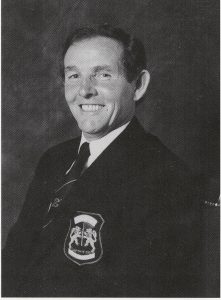
It is my pleasure to write this Foreword to David Horncastle’s compilation of 100 Years of Golf on Doncaster Town Moor.
The challenges met and overcome by our predecessors as described in these pages show that, when the need arises, the Club has always had members of great character willing and able to respond in times of adversity.
From the first nine holes cut out of the ‘Doncaster Common’ in 1895, to our present problems of maintaining a full 18 holes because of the forty yard incursion, there have always been members who have come forward and risen to the task set them. Long may it continue.
At the end of the first 100 years, it is pleasing to look ahead in the knowledge that Doncaster Town Moor Golf Club has its own Club House on land leased for another 59 years and a licence to play golf on Doncaster Town Moor for the same number of years.
Our successors in the 2050’s will have some work to do…
D. J. Walker President, Doncaster Town Moor Golf Club
The Early Years
Golf on Doncaster Town Moor (or the Race Common, as it was then called) began at an Extraordinary General Meeting of Doncaster Golf Club held on 6th July 1895, when a decision was made to move the Club from its site at Greenhouse (now the Cumberland Hotel), near the Royal Infirmary.
Without-delay, the assistance of George Lambert (the professional at Wakefield GC) was sought and within a fortnight a 9 hole course had been laid out. The rapidity of building such courses was a feature of the great 1890’s golf boom, when the number of courses nationwide grew by one third. Such courses were primitive by modern standards; the greens were small areas cut more closely than the fairways. The natural terrain was used to provide obstacles — more sophisticated hazards, such as bunkers, were put in later as required.
A notice in the local press drew the public’s attention ‘the fine new links of the club on the Race Common were now open for play and that the club rooms were in a cottage at the back of the grandstand where the services of a professional could be engaged by those desirous of coaching.’
The move to the Race Common was not without its attendant problems. Racehorses were trained there and for several decades into this century the St. Leger Race Meeting in September was attended by vast _crowds of up to a quarter of a million people. Those who could not afford to pay for entry to the stands and enclosures could place bets with bookmakers who set up pitches along with a fun fair on what was then known as the ‘free course’ (now the practice area). The multitude would spread out all over the Race Common and the Race Committee would not allow golf to be played at this time.
Apart from horse racing, the uses to which the Race Common could be put were many and varied. Apart from local people taking a walk with their dogs, the local boys used it to play football and cricket and the Yorkshire Dragoons used the area for an annual training camp. In 1909, the country’s first Air Display was held on the Race Common and utilised most of the area.
However, the game prospered and at the AGM of the Doncaster Golf Club on 6th January 1896, held at the Volunteer Depot, it was reported that the membership had risen to 50.
On 27th March 1897, the first recorded golf match took place on the Race Common against Barnsley GC. Contested by two teams of 6 players, Barnsley won 3 matches, Doncaster 2, with one halved.
At the AGM that year, Rupert Beckett, of Beckett’s Bank (now the National Westminster Bank) was elected President. He was the grandson of Sir Edmund Beckett, the West Riding MP who was responsible for bringing the railway through Doncaster in the 1840’s. This, together with the opening of what eventually became known as the Plant Works in 1853, led to the extensive industrialisation of what had once been a pleasant market town in the heart of a rural area.
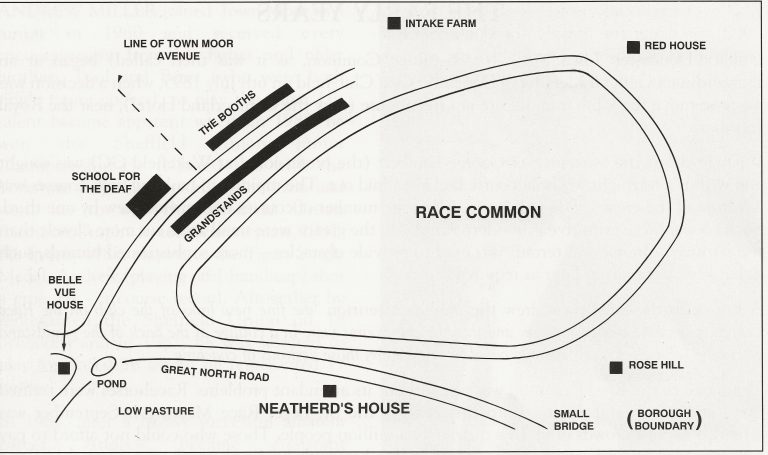
This sketch shows the Race Common and its environs in 1895.

This photograph, reproduced by courtesy of the Doncaster Museum & Library Service, was taken on St. Leger Day, Wednesday 1 1 th September 1895, just before the big race which was won by Sir Visto, owned by Lord Roseberry. Rose Hill Farm is visible on the horizon. The crowds in the Silver Ring and spreading all over the golf course can be seen
The Beckett family lived in a large house on South Parade (now Council Offices). The Hon. Rupert Beckett (as he became in 1905) was no figurehead president — he played golf to a handicap of 10. He was friendly with the Prince of Wales and when the latter visited Doncaster Races (he won theSt. Leger with Persimmon in 1896 and Diamond Jubilee in 1900), no doubt the presence of a golf course inside the track was pointed out to him. The future king was a golfer, but there is no record of him having played on the Race Common.
Golf in those days was but one of several pastimes competing for the leisure time of the well-to-do. Ladies took up the game in increasing numbers when a full swing became acceptable — until then it had been considered undignified for a lady to take the club above shoulder height! From 1908, the Ladies Section of the Doncaster Golf Club were accommodated in a room at Belle Vue House (now the St. Leger Hotel).

The Hon. Rupert Beckett
By now, golf was firmly established on the Race Common as the following entry in The Golfer’s Guide Vol. IV, 1897, reveals:
Doncaster Golf Club, ‘Doncaster, Yorkshire. Inst 1894 — It is a nine-hole course on sandy soil; the hazards consist of sandpits, gorse, ditches and railings. The green is situated on the Race Common, one and a half miles from the station. An omnibus runs within 300 yards of the club-house, and cabs can be had at the station.
Pres. Rupert Beckett; capt. P. H. Grimes; hon. secs. J. W. Young and Ernest Wilson, 25, Hallgate; and a committee of five other gentlemen; greenkeeper, Alexander Duncan, 2, Pavilion Street. Mem about 70. Professional record, 77, F. Goldsmith, 1896; amateur record, 83, George Wilkie, 1896. Medallists and trophy winners for 1896 — George Wilkie, James Matthews, Rev. William Tatham, and J. W. Young. Entrance fee £1,1s; sub £1, ls. Visitors — Three days free, after that is a day or 2s 6d a week.
One of the above-mentioned trophy winners, the Rev. William Tatham, was the Vicar of Cantley and Branton from 1892 until his death in 1938. He had lost an eye in a shooting accident and took up golf as a suitable pastime.
The problems of ‘outside interference’ have already been mentioned and when, in 1907, the attention of the Doncaster Golf Club was drawn to a tract of land near Rossington Bridge (known as The Warren’) the Doncaster Golf Company was formed for the purpose of renting the site from the Jarratt Estate (the Jarratt family lived at Elmfield House) with the intention of building an 18 hole course there.
This plan did not have the approval of all the existing membership. Bessecarr (as it was spelt in those days) was not the heavily populated area we see today; it lay outside the borough with no more than a handful of private dwellings and farmhouses. For those who lived in Doncaster, the prospect of travelling three miles to play golf without some form of transport (ie. horse-drawn or by bicycle) was uninviting. The motor car was a very expensive luxury — Henry Ford’s mass production of the Model T was two years away. In 1911, the Doncaster GC successfully negotiated the construction of a Railway Halt to make the course more accessible.
Despite the opposition, the proposal was passed and on 8th February 1907, the Doncaster Golf Company was formed. The shares were not put on public offer, for enough support was received from the existing membership to make the project viable. In December of this year, the first Annual Dinner was held in the Luncheon Room at the racecourse. It was attended by the Mayor and other local dignitaries.
As work proceeded at Rossington Bridge, for a time it was possible for members to play nine holes on each course) But it became increasingly apparent that it was not going to be financially viable for Doncaster Golf Club to maintain the two sites. Accordingly, the 9 holes on the Race Common were offered to the Borough Council for use as a municipal course. To the Club’s surprise and disappointment (for £1500 had been spent on course development) this offer was turned down at a Council Meeting on 21st September 1910 (Min 162M).
No reason was given for this decision and the members were faced with the prospect of the 9 holes on the Race Common fading out of existence. This could not be allowed to happen. A meeting was called and the report in the Doncaster Chronicle for 3rd March 1911, reads:
TOWN MOOR GOLF CLUB
At a largely-attended meeting on Wednesday night, of ladies and gentlemen, interested in the upkeep of the Old Golf Links on the Race Common, a new Club was inaugurated under the above title. A strong committee was formed, and it is anticipated from the promises already received that the new club will have a large membership. As the majority of the supporters are also members of the Rossington Club, there can be no sense of rivalry, but rather it is hoped, that the one will act as a nursery to the other. The subscription proposed is one guinea for gentlemen and 15s for ladies. Dr. Langley, “The Mount,” Thorne Road, was appointed hon. secretary.
The newly-formed Town Moor Club took over the links on the Race Common but two years later ran into difficulties for on 8th December 1913, the Race Committee turned down another application for the links to be made municipal on the grounds that golf was about to become available at Wheatley Park (Min 45E).
On the outbreak of World War I, the military authorities took over the Race Course for use as a remount training centre for the cavalry. The booth was requisitioned (24th September, Min 179E) and on 12th November (Min 5E) the Club was allocated a stable at Belle Vue for changing purposes. Use of this was allowed free until 31st December, but after that a rent of £10 per annum was paid.
On 16th February 1916 (Min 25E), the Race Committee agreed to an application from the Club that the rent be reduced to £5 per annum. On the 24th August (Min 51E) the Club again asked to be relieved of their rent and to surrender the stable and offering to pay a retaining fee of a guinea a year. This was accepted, payable in advance. The Club had reached its lowest ebb.
Evidently this was the end of golf on the Race Common. It was by no means an isolated case, for the war had taken its toll on many golf clubs who had their courses requisitioned for agriculture. However, the surviving Town Moor members refused to be beaten. Recovery came on 25th April 1921, when the Race Committee (Min 113E) granted permission for the Club to make use of the links on the Race Common. On 6th May, the Chronicle report reads:
TOWN MOOR CLUB REVIVED
The Doncaster Town Moor Golf Club, which lapsed during the war owing to the course being used by the military, is to be revived. This decision was arrived at on Tuesday night, at a meeting held at the Albany Hotel.
Mr W. Hanson, presided, and said the Race Committee had received a deputation, who explained that they wished to revive the old club, and to get the links in order as soon as possible. The deputation suggested that the labour difficulty might be got over by the Race Committee allowing their men to do the work and charging the club with the expense. They were able to assure the Committee that the players would not be on the course when horses were in training. The Committee agreed to supply the labour, and also to allow the club one of the booths for use as a club house, on the understanding it was vacated during race meetings. The deputation suggested that if the club were formed, they meet Mr Ford and go over the ground with him in order to point out where they wanted the greens. They thought they would be able to manage at first with seven greens instead of nine. The Race Committee accepted the suggestion of the deputation.
Mr Walker (secretary pro-tem) said if the club were launched there was no doubt they would get a lot of members… at present they had a guarantee of about 21 members .
Mr Baguley proposed that the club should be re-formed and this was seconded by Mr Brown, and agreed to.
It was decided to ask the Mayor to become President of the Club. Mr L. Vaughan was elected secretary and Mr Baguley, treasurer, and it was decided that the subscription should be 30/- for the first year for men £1 for ladies.
The above report tallies with that written for the Gazette who also noted that the cost of labour for the first month to six weeks would be the biggest item to be faced and that there was to be no entry fee.
On the 27th June (Min 194E) the use of one of the booths was authorised at a rental of £2 per annum, with the proviso that the Club did its own repairs and vacated the facility during the St. Leger Race Meeting.
On 28th February 1922 (Min 46E), the Club was allocated the use of a second booth. However the booths were never to provide anything more than a changing facility and a space for club storage. For refreshment after a game the nearest bars were at the Rockingham Arms (1778, rebuilt c1923) or the Earl of Doncaster (1816, rebuilt in the 1930’s), both situated on Bennetthorpe. Ironically, the booths had been built early in the 19th century, for the use of innkeepers and publicans to provide a service for thirsty racegoers…
It is of interest to note that Doncaster Rovers FC were reformed in 1920, and played on a ground on Bennetthorpe, where the William Nuttall Cottages have since been built (prior to 1916, they had played on a ground owned by the Yorkshire School for the Deaf, off Town Moor Avenue). The Rovers moved to their present location at Belle Vue in 1922.
The tram service, with its turning circle at the bottom of Town Moor Avenue, continued to provide access to the Club until 1930 when it was replaced by the electric trolley service which ran along Bennetthorpe to the Race Course Corner before turning up Carr House Road, thus leaving golfers with a longer walk to the booths.
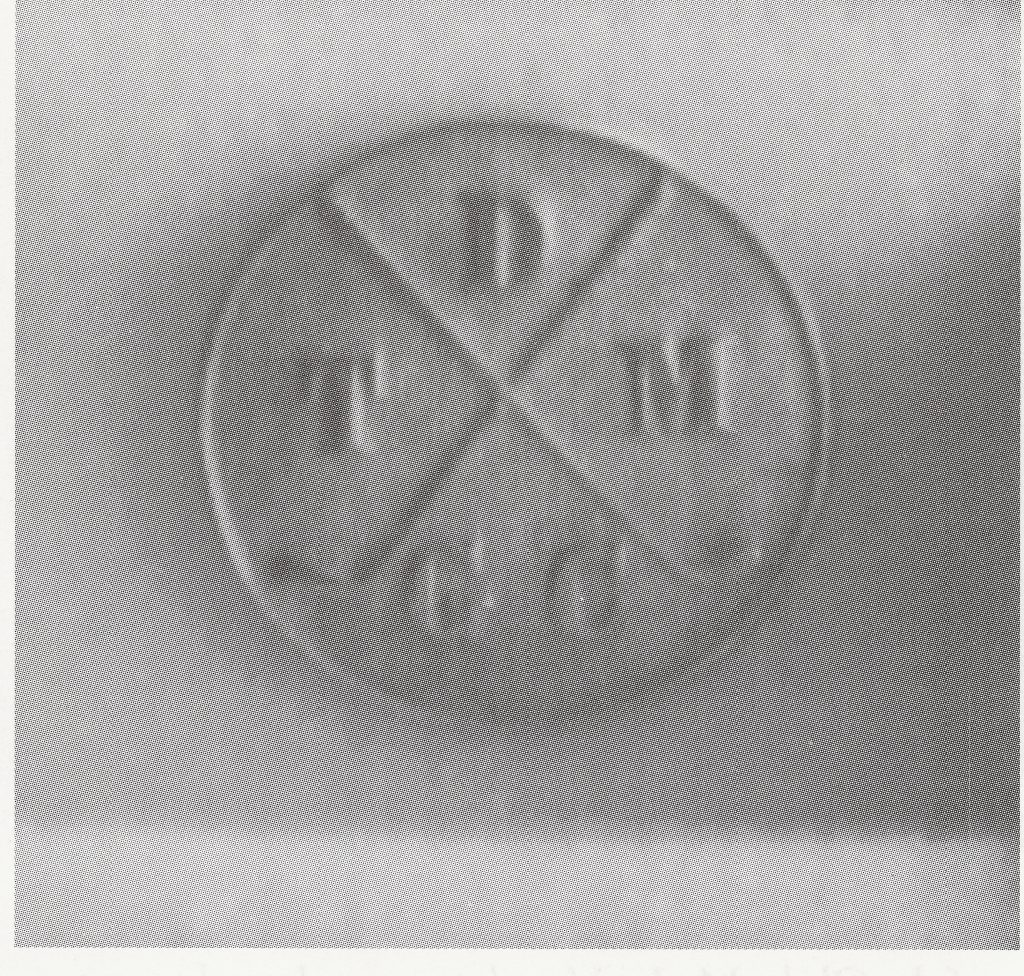
This is the original club badge, engraved DTMGC. This example dates from the 1920’s and is owned by David Smith, the grandson of the late Clarence Smith. The badge was worn also by the ladies, who took them to Bell’s the Jewellers, to have them dipped in gold.
When the tram service began in 1902, a golfer could travel from the town centre to Grandstand Road (as it was then called) for the standard fare for all routes — ld. The driver worked a 54 hour week for which he was paid a maximum wage of El 7s Od (E1.35p). Such hours and pay left little opportunity for the driver to join his passengers for a game.
Present members of Town Moor owe a great debt to this handful of dedicated golfers who so successfully revived the Club, that in the Gazette for 10th February the following year it is reported that 120 attended a dance at the Lyceum Cafe; Mr Hundscome’s band provided the music and the arrangements were in the hands of the entertainments committee.
The biggest obstacle to the development of the Club was the lack of bar facilities; many potential members must have been lost to Doncaster GC and Wheatley Park GC, who had their own club houses.
Nevertheless, the Club prospered, for in 1930, the Chronicle reported the seventh annual dinner and dance now held at the Danum Hotel. Mr T. W. Plant, the president (who owned a clothing business in Doncaster) was in the chair and in the absence of the Mayor, Councillor T. H. Johnson responded to the toast of “The Mayor and the Corporation”. The President’s Cup was presented to Mr Shelbourne (the Captain) and the President’s Ladies Cup to Miss Heath.
On a Saturday in July of this year a match was played against Robin Hood GC on Town Moor. The Robin Hood Club had been formed at Owston Hall in 1923. Each side was represented by 12 players. The match was an all-day affair. Town Moor won the singles in the morning by 7/5. After lunch, the two teams played foursomes, the result being a half.
THE MOVE TO NEATHERD'S HOUSE
In 1930, an article appeared in the press on George Webster, the tenant of Neatherd’s House on Bawtry Road. This man, who was nearing the end of his days, had been born in a cottage on the same site in 1851. The cottage was burned down shortly after he was born and was rebuilt in 1853.
Mr Webster claimed a family association with the place for 300 years and as neatherd (an ancient name for a cow-herder) was responsible for the management of the rights of freemen and common-right owners to graze their cattle and sheep on what was known as Low Pasture (the area now occupied by the Dome development) together with the Race Common.
According to Mr Webster, there were settled dates for the transference of cattle which had to be moved away from both the pasture and the race common for the winter months. When they were brought back, they were branded DLP (Doncaster Low Pasture). Freemen had to swear to their ownership of sheep and cattle on certain dates.
The old man recalled the days when there was only a single stand for the race course with boxing booths and cock-pits at either end. His family had many dealings with the racing fraternity for before the railway came, horses had to be walked from Newmarket to take part in Doncaster Races and were fed and watered at Neatherd’s House.
By 1930, Mr Webster’s tenure was coming to a close and coincidentally, Wheatley Park GC were about to become deeply involved with a move to their present site on Armthorpe Road.
At the AGM held on 18th March, 1932, the Town Moor secretary, Mr G. C. Knott reported a membership of 141 (an increase of 10) and the treasurer (Miss E. M. Lister) reported a balance of £38.
`The secretary then reported an offer from Wheatley Park Golf Club to take over the membership of Town Moor at reduced fees, together with the assets of the Club. The fees suggested were 3 gns for men and 11/2 gns for women for two years.
The resolution that this offer be accepted was moved by Mr A. Vasey, seconded by Mr J. Harvey.
Mr Harvey said he thought that under present circumstances of play on Town Moor, this was a business proposition.
The secretary pointed out that it was hoped to make the new course at Wheatley one of the best in Yorkshire and members had to consider the position in two years time. He thought the best decision would be made by a ballot of the members.
The President (Mr T. W. Plant) pointed out that the same difficulty of people walking over the public land on Town Moor was experienced when the Club was first started many years ago. The offer, he thought, was a fifty-fifty one.
The Chairman (Mr S. Taylor) said that on the one hand they had a thoroughly thriving club and on the other hand at Wheatley better amenities and wider opportunities. It was a matter of weighing up the two positions: was it worth while?
The resolution was lost by three votes but a further resolution that the matter be referred to a ballot of members, a majority of two-thirds to decide, was carried.’
The result of the ballot is not even mentioned in the AGM report for the following year, but it is obvious which way it must have gone. Mr Knott reported that the membership stood at 126. There were 81 men and no less than 45 women — a very high ratio between the sexes when compared with today. There was a reduction of 15 in the membership. No reason was given for this (other clubs were losing members because of the effects of the depression), but the Club must have felt confident, however, for the subscription was raised to £1 15s for men and £1 5s for women; entry fees were £1 5s and 15s respectively.
On 9th February 1932 the press reported that: The Town Moor Golf Club have taken over the house known as ‘The Neatherd’s Cottage’, occupied for many years by the late Mr Webster, near the race course. This will be the club house in future.’
The Club’s tenancy was confirmed at a meeting of the Race Committee on 28th November 1932 (Min 34) which recommended that Neatherd’s Cottage be let on a quarterly basis.
The Club Captain during this important move was Mr H. B. Wilson, whose name is remembered when members play for the Wilson Cup.
From now on we have access to first-hand recollections. Les Oldfield joined the Club in 1933 when Mr H. K. Bailey was Captain. Les recalls using the booths on what was then called Grandstand Road (now Leger Way). The young Les Oldfield was to remain a member of the Club, serving his fellow members in all the major offices of Captain, Secretary, Treasurer (for 25 years) and President and is now an Honorary Member.
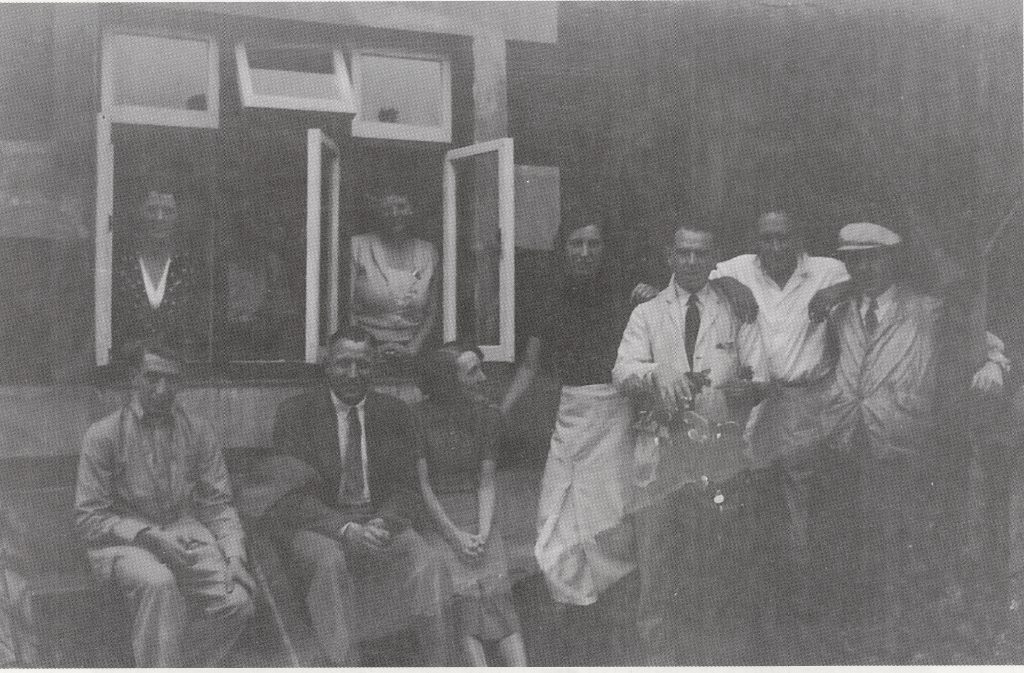
The stewardess, Mrs Robinson and her husband, Walter (on the right) and her daughter, looking out of the window of what was then the bar at Neatherd’s House. In the early 50’s when the new bar was fitted, this room was converted into a kitchen. The locker room was situated upstairs until an ex-RAF wooden hut was acquired in the 1960’s.
From the left: Paddy Mills, Jock Tawse, Cath Cudworth, Edna Lupton, Tom Rhoden, Sergeant Major Bill Bush (who was killed at Singapore in WW2) and Ham Lloyd.
Tom Davis, the Chief Constable, was a member of the Club at this time. He won the Plant Cup three seasons in a row (1932-33-34) and encouraged members of the force to play the game. Before World War II, both the Police and the Doncaster Rovers players had block memberships with the Club (RAF personnel did not come in on this basis until around 1960).
The facilities at Neatherd’s House were only those provided by a run-down cottage. The locker room was upstairs (it was not until the mid-sixties when an ex-RAF wooden but was acquired).
On 8th February 1934, the Race Committee (Min 39) approved an application from the Club for the provision of lavatories at a cost of £115. The Club’s rent was raised to £35 per annum to help pay for this.
At this time, work was proceeding on the construction of Doncaster’s civilian aerodrome. This was formally opened on 23rd April 1934. For a time, the Dutch KLM Airline flew civilian flights from here but it was requisitioned by the RAF during World War II.
On 15th April 1935, the Ladies Section formed a Committee to run their affairs. Until then, the section had been run informally by the captain and her vice-captain. The first Committee members were: Mesdames Knott, Hopton, Thirsk, White and the Misses Heath and Howden. A handicapping committee was formed by Mesdames Timms (Lady Captain), Townend, White and Miss Heath.
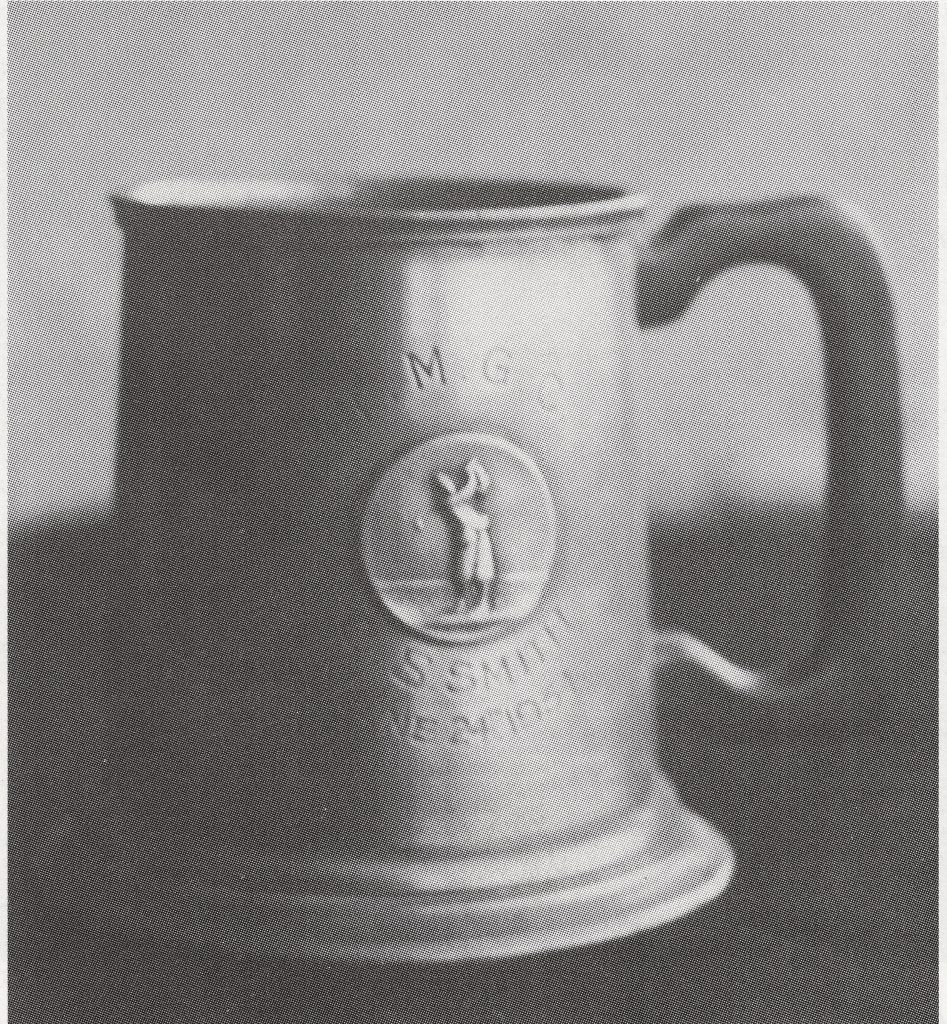
This engraved tankard was won by Clarence Smith in 1934. Clarence was present at the opening of Neatherd’s Hourse. He died in 1985, aged 95.
At the first Ladies Committee meeting, it is minuted that: A request is made that ladies use discretion and not remain in the Bar when a number of male members of the Club were present — this was noted. No doubt a similar request today would trigger a robust reaction! But the reality was that the bar was so tiny that the ladies were quite happy to`concede the point.
It is of interest to note that the Club’s Honorary Treasurer during the 1930’s was Miss E. M. Lister. Elsie Lister was the manageress of T. W. Plant’s clothing business in Doncaster and she was succeeded by Miss Grimwood who held the office until 1950. It has to be said that it was (and still is) very unusual for a lady to hold a management committee office in a golf club. It must be pointed out that Town Moor have always allowed the ladies a vote at their AGM and for several years now have allowed a lady representative to sit on the Management Committee. The Club has always been decades ahead in its thinking on such matters.
In the late 1930’s, Maurice Birkett started out as assistant to Joe Garrod, who was then professional at the Club. Maurice moved to Doncaster GC in 1938 and remained associated with that club for the next fifty years. Maurice recalls how he and Joe laid what is now the 7th green in 1935. Joe married and moved to Scunthorpe GC. War service in the RAF interrupted the careers of both men and afterwards Joe left golf to work in public house management, playing his golf at Wheatley GC as a reinstated amateur.

Taken at Abbeydale Golf Club in the late thirties. From the left: Town Moor members Alec Ansell (a former WW1 fighter pilot), Frank Heyes and Joe Garrod (Town Moor Professional 1936-38). On 4th August 1938, Joe broke his own course record by two shots with a 65.
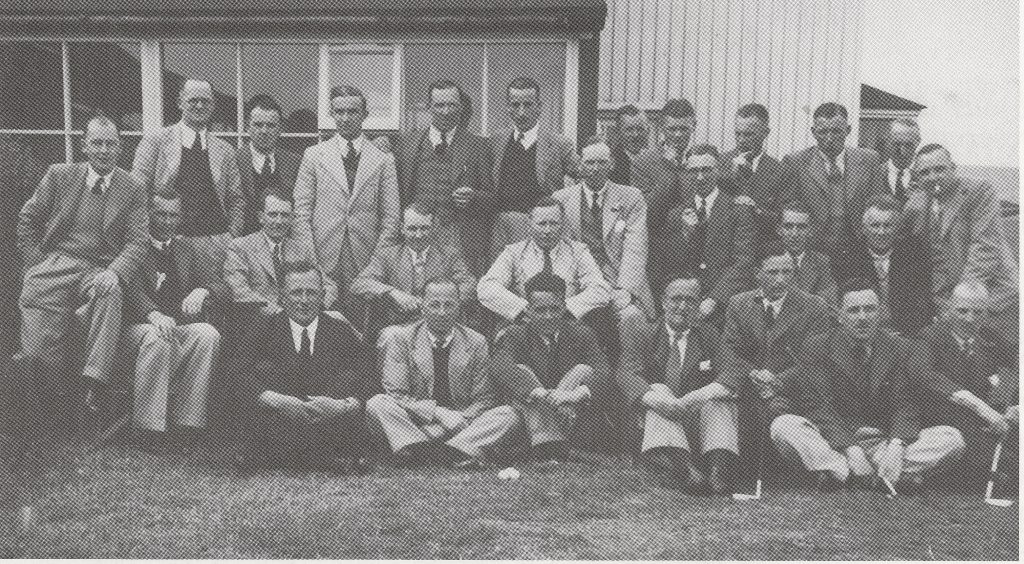
The second Dormy Outing to Filey in 1938 (the first was to Hornsea the previous year). The only man missing is the photographer, Les Oldfield! Back row, from the left: Bill Hopton, Ernest White, Tom Rhoden, Fred Outwin, Arthur Richardson, Arthur Wilson, Les Stephenson, Ken Beaumont, A. V. Rawson, Jack Howden, Jock Tawse, Arthur Peart.
Centre, from left: Avril Vasey, Viv Taylor, Phil Dorling, Alec Ansell, Clarence Smith, J. W. Mills, Bert McQuillan, Albert Wills.
Front, from left: Arthur Sleath, Harry Lawson, Harold Bradley, H. B. Wilson, Syd Timms, Sam Acaster, Inspector Howard.
These annual outings have proved very popular with members over the years and in the early days, a football sweep was instituted to fund them, with 6d going to the draw and 6d to the outing.
Maurice Birkett was Assistant to Joe Garrod 1936-38. He is pictured here teeing off in an Exhibition Match at Wheatley GC in 1944.
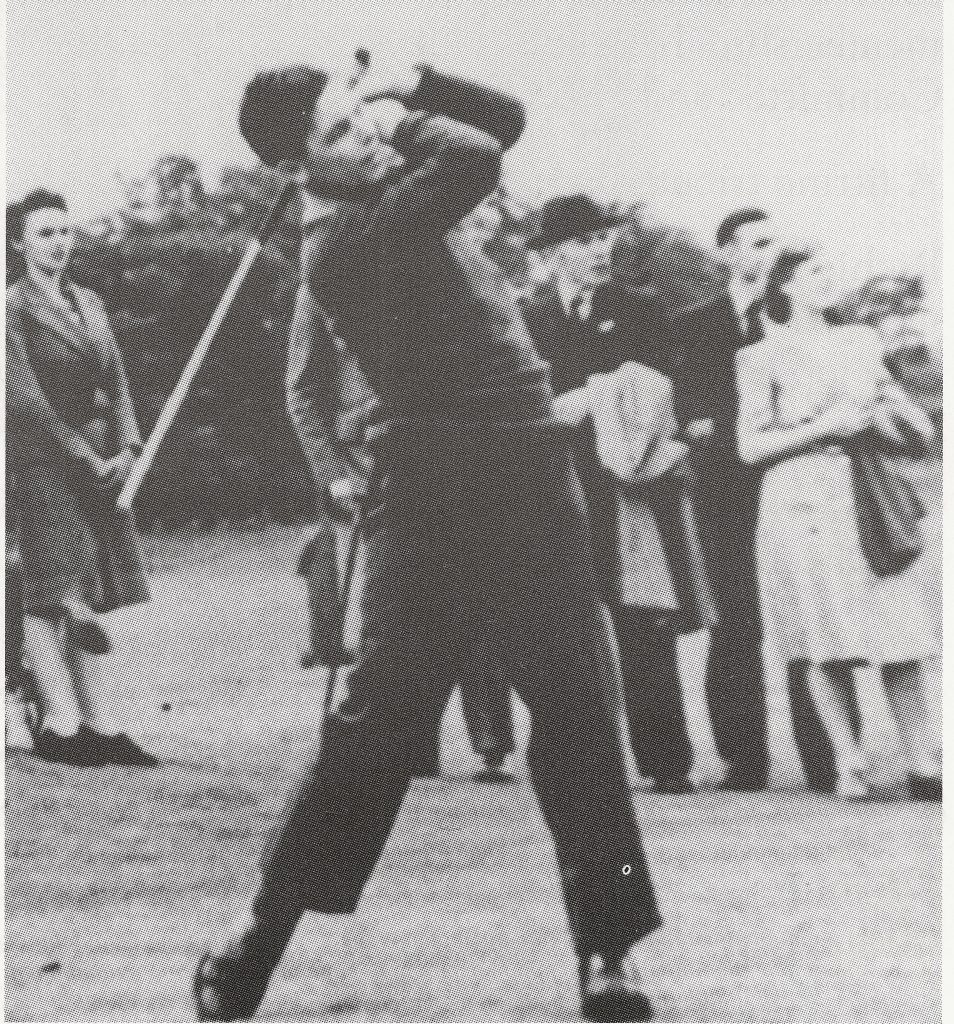
WORLD WAR TWO
During World War II, the younger members of the Club were called up for military service or employed in reserved occupations in the coal and railway industries. Golf was kept alive on Town Moor largely through the dedication of older members such as Arthur Richardson, Avril Vasey, Clarence Smith and a handful of others. The situation was not as bad as World War I, for the military did not use horses to the same extent, but nevertheless, prisoners of war were held in the requisitioned Race Course premises. In December, 1946, National Hunt racing was revived (after a gap of 35 years) and the presence of the new jump track reduced the area available for golf.
.
THE POST WAR RECOVERY
In 1950, the subscription was £2 lOs and it rose to £3 in 1954. By 1960, it was 6 guineas. The green fee for a round of golf cost 2/- in 1948 and in 1961 it had risen to 3/6d (7/6d weekends and Bank Holidays).
Arthur Richardson or Richie’, as he was universally known, worked tirelessly for the Club. Born in Appleby in 1891, he moved to Doncaster in 1921, where his son, Don, was born. In those early days he lived in a cottage on the site of the present Fire Station (built in 1936). He was involved in the management of Mudd’s, a welding and boilermaking firm on Shaftesbury Avenue, Intake. He joined the Club in 1923 and was Captain in 1934-35 and 1941-42 and President 1957-63.
In the late 1950’s Richie embarked on an ambitious plan to develop the course and worked tirelessly for almost a decade to turn it from 9 to 18 holes. Les Oldfield stresses that none of this work entailed any excessive increase in the subscription and at the AGM of 1964 when Richie resigned as President, he remarked that ‘in my opinion Town Moor has been a very fortunate club in having such a remarkable person amongst its members. Thirty five out of a total of over 40 years membership have been devoted to the club in some official capacity as President, Captain, Committee and Greens Chairman.’
A fitting tribute, indeed.
Richie was given a gold watch and appointed Life Vice-President. In 1967 he was made ex-officio member of the Committee, to avoid having to undergo re-election. His interest in course development never waned and his last contribution was the development of the present 10th green. Richie played golf until well into his eighties and died in 1987, aged 96.
The development work was carried out by John Scott, with the assistance initially of members such as Howell Edwards, Wilf Thompson and latterly Les Wills, G. Ward, Ray Bint and Don Richardson.
John Scott, who succeeded Willis Evans (who went to Blakeney), came to the Club from Rushden GC in 1959. In 1963, plans to extend the course from 12 to 18 holes were made and when in 1967, John left for Wetherby GC (back to his home town) the Club had been in possession of an 18 hole course for nearly two years.
On John’s departure, he was replaced by Ian Gosney, an assistant at Thrybergh. Ian became the first Club Professional in the modern sense of the word, for previously the job entailed being a greenkeeper, professional and steward rolled into one! But it must be remembered that the Club now had 18 holes and was taking in more members in response to the growing demand to play golf, which was given a terrific boost when Tony Jacklin won the Open in 1969. Until then, golf courses had been relatively empty spaces mid-week — in marked contrast to the steady flow of play at all times witnessed today. As a consequence, the wooden locker room was added (the AGM of 1966 was held in there) and the bar was extended by an annex added to the main building, an improvement for which the members were levied £5 a head.
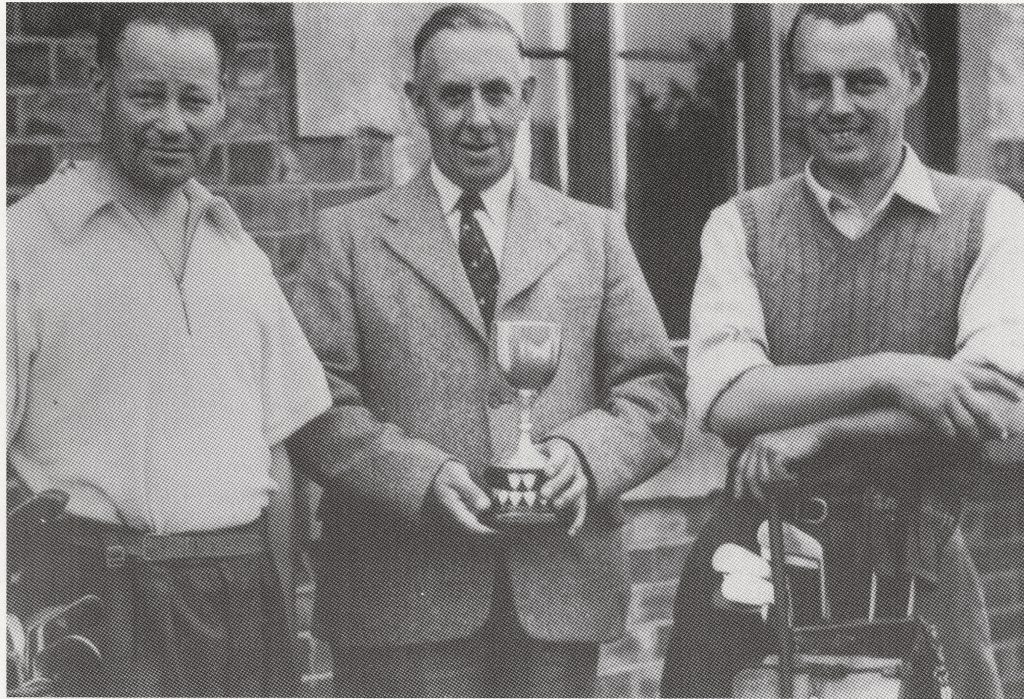
1949: In the centre, Mr W. D. Morton, holding the President’s Cup. On the right is the winner, Les Oldfield, on the left is the beaten finalist, Fred Flower. Mr Morton succeeded T. W. Plant as President. He was Area Electrical Engineer for the NCB. (By courtesy of the Yorkshire Post.)

September 1950: This photo shows members celebrating the opening of the new bar at Neatherd’s House.
At the back, from the left: Clarence Smith, Ted Blackbourn (President), Irene Burgin, Ken Smith, Ernest Rowley (Steward), Bob Rose, the Steward’s son, Stan Heselton. Middle row: Alec Ansell, Harold Bright, Joan Bright, Marcia Kirkham, Ron Burgin, Lilac Otley (Ladies Secretary), Grace Burgin, Dot Yeardley, Ethel Blackbourn, Connie Lambert (no relation to Gilly), Harold Burgin. Front row: Mrs Burgin, Arthur Richardson, Nancy Townend, Geoff Blackboum (Hon. Sec.), Billy Harding, behind Billy (hands on his shoulders) Harry Carey. (By courtesy of the Yorkshire Post.)
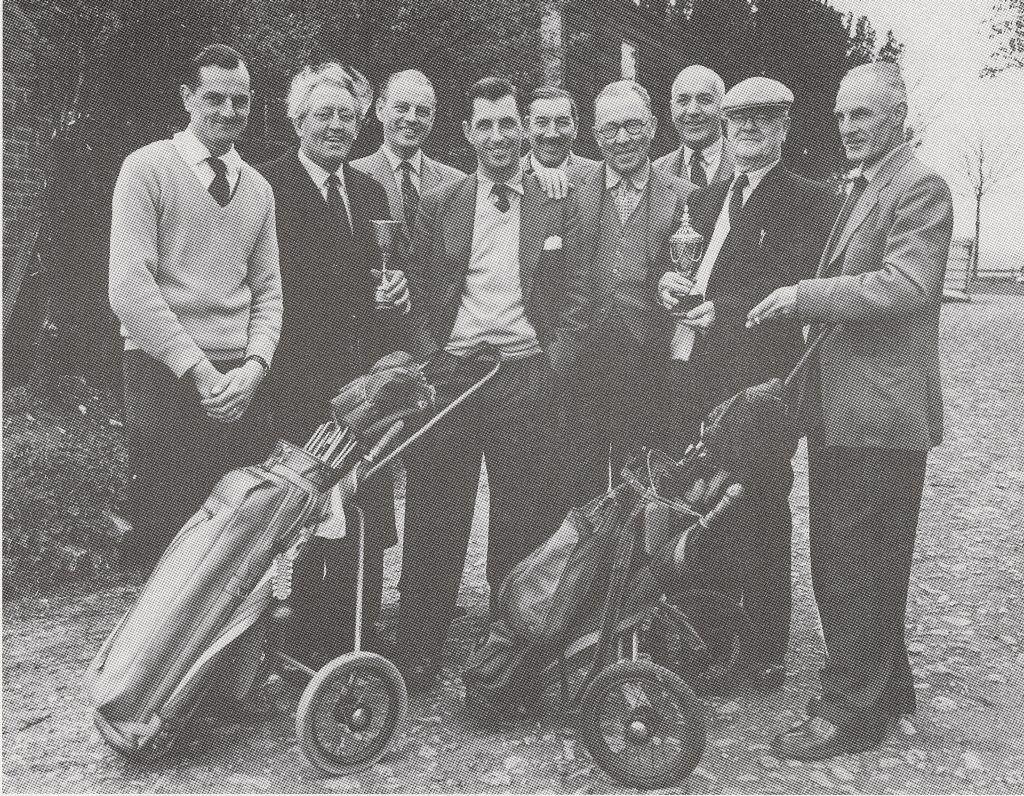
1959: From the left: Brian Stace, Norman Abbott (Captain), Les Oldfield, Peter Robinson (Captain 1957-58), Roy Hopkinson, Arthur Richardson, Vincent Hann-Smith, Ted Blackbourn (President) and Jack Howden (Captain 1939). (By courtesy of the Yorkshire Post.) (Note the narrow wheeled trolleys which first made their appearance in the early 1950’s. A `Kaday King’ in those days cost 95/6d from Gamages.)
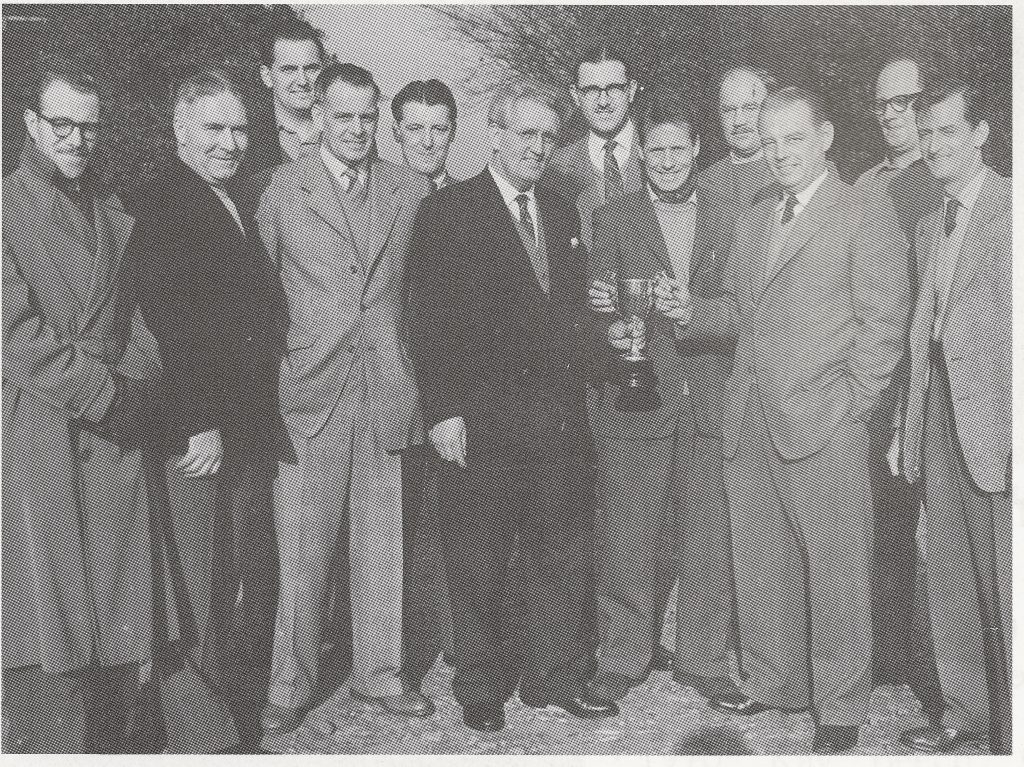
1959: Norman Abbott, Captain, presents Peter Gethin (holding trophy) and Les Oldfield with the Wilson Cup. The others are, from the left, Jack Rimmington, Reg Nield, Maurice Cartwright, Tom Smith, Arthur Angus; Gordon Adams and Maurice Hunter are standing behind the winners and on the right, Eric Chester and Jim Smith. (By courtesy of the Yorkshire Post.)
THE DEVELOPMENT OF THE COURSE

This diagram shows the course as Les Oldfield remembers it in 1932. This could well be very close to the original layout of 1895, recovered when the course reopened in 1921. The training or ‘tan track’ as it was called, of which there is very little evidence left today, was in regular use by horses in training until well after World War II. Racing fans will recall Avril Vasey trained horses on Town Moor. He was also a keen golfer and was Captain in 1937 and 1948.
In July, 1933, we have Town Moor’s first recorded hole-in-one, when Phil Dorling had an ace at the 4th Hole. Known as the `Quarry Hole’, this feat was witnessed by Clarence Smith and reported in the press. The quarry was a feature of the course until the 1940’s, when it was filled in. Recent work on the course by the greenkeeping staff has revealed evidence of its former presence. Military cartridge cases have also been found — evidence of the former presence of the rifle range
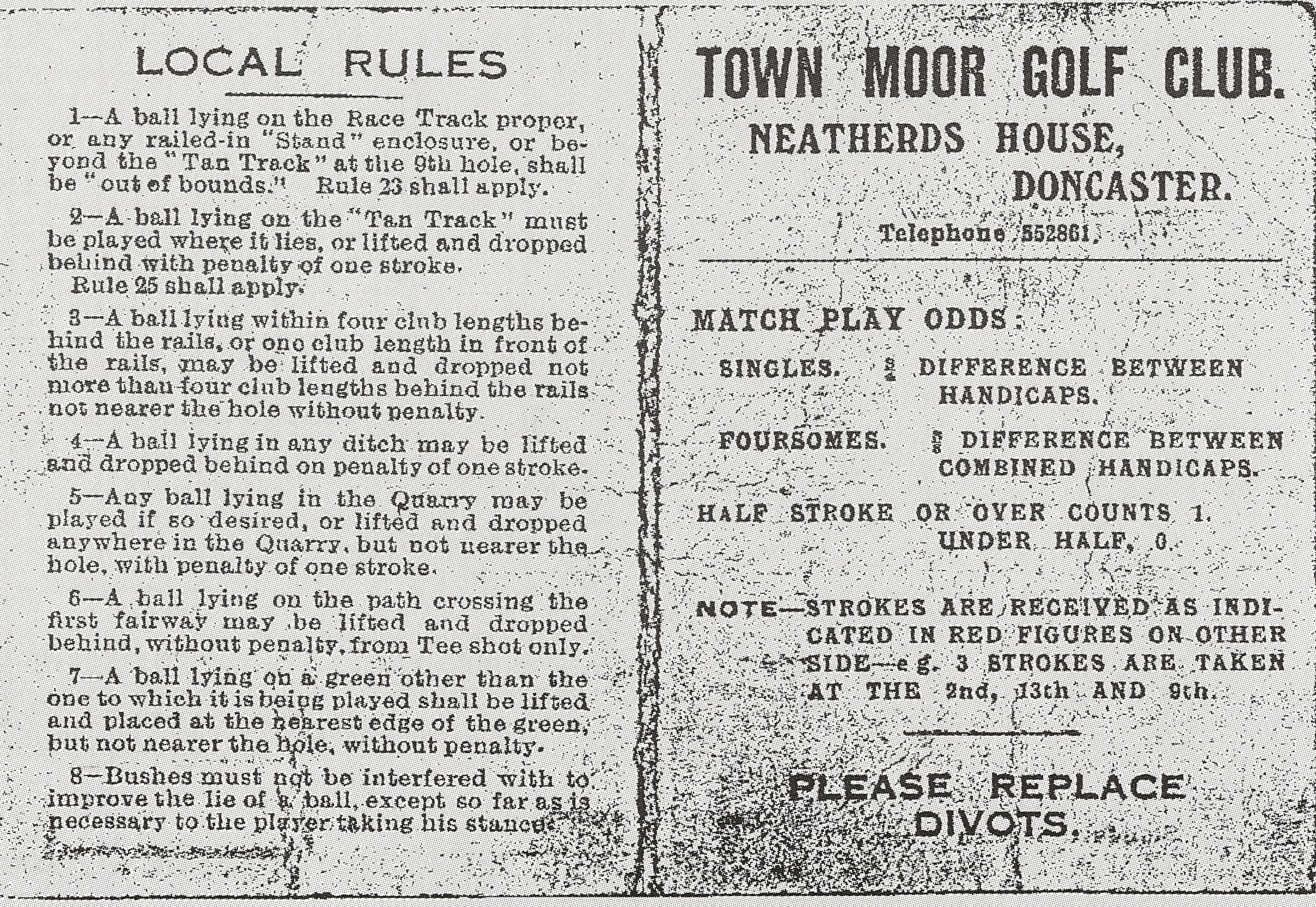
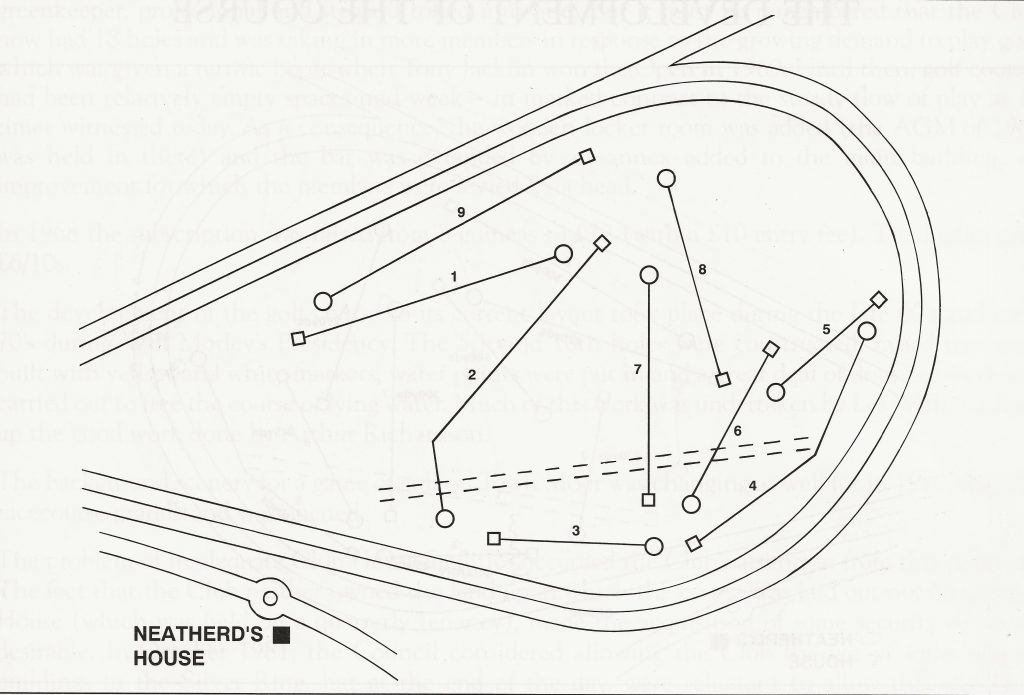
This diagram shows the 9 hole layout on John Scott’s arrival in 1957. The course progressed to 10 and then 12 holes before becoming the full 18 in 1965.
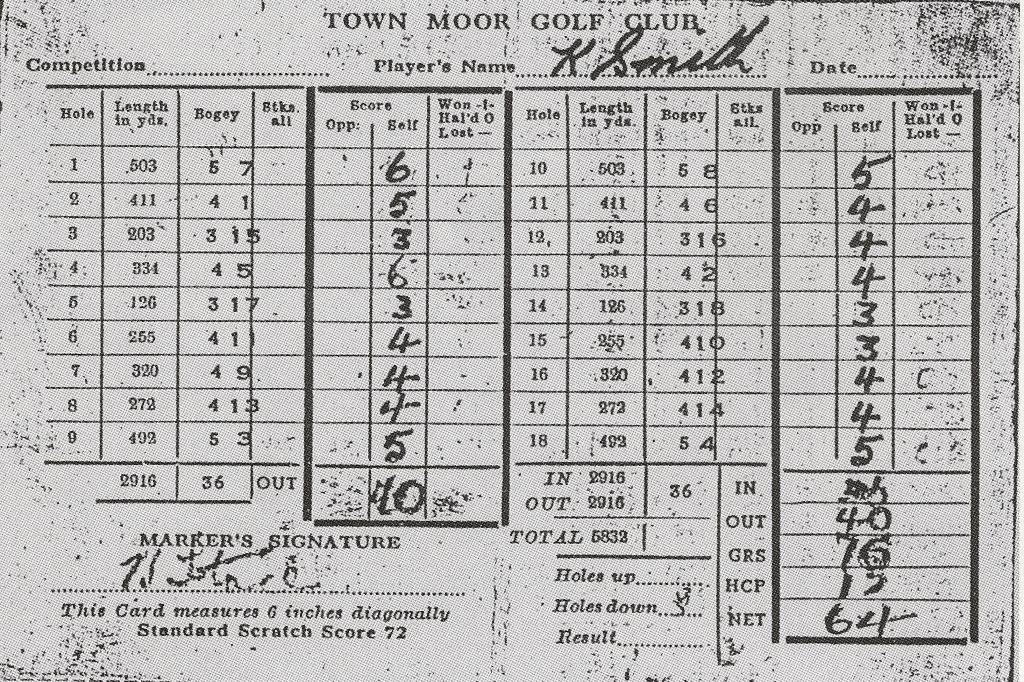
CARD OF THE 9 HOLE COURSE — with scores made by Ken Smith (Clarence Smith’s son) just after World War II.
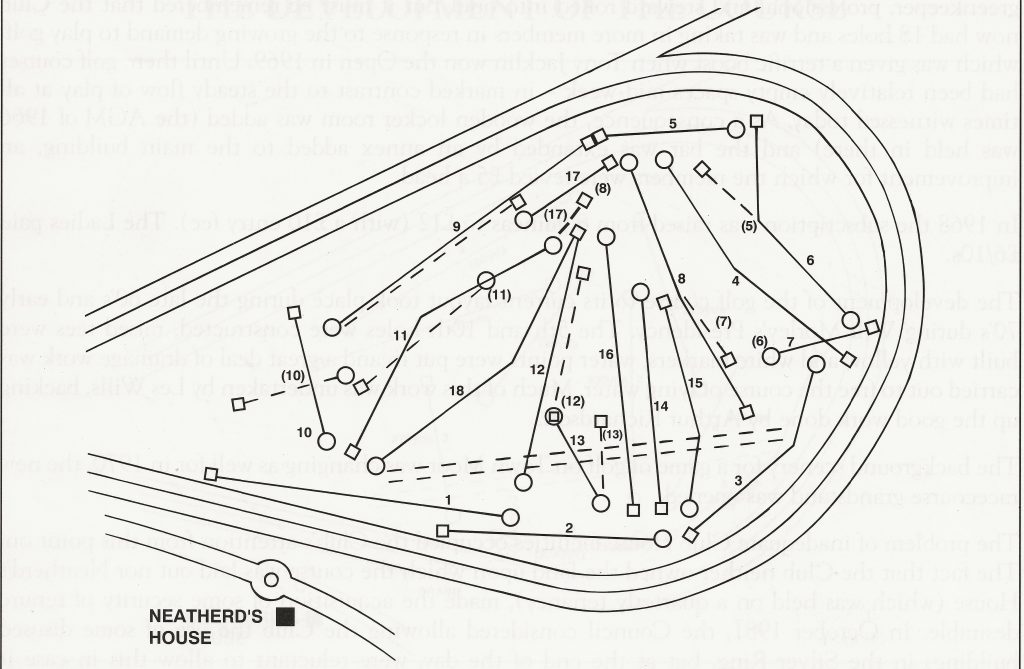
This diagram shows the course in 1966 superimposed over the present layout. Older members will remember that Town Moor used to have extensive areas of unplayable waist-high marsh grass. In wet weather, large areas of the course were prone to flooding and this was eliminated in the 1970’s by the introduction of an extensive drainage system.
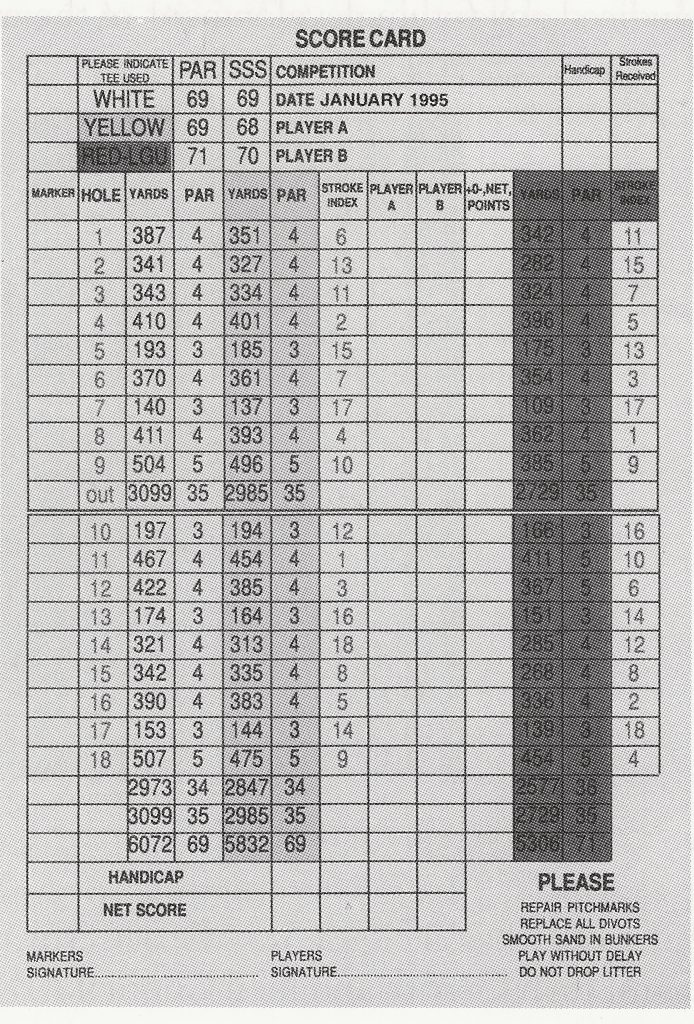
In 1968 the subscription was raised from 8 guineas to £12 (with a £10 entry fee). The Ladies paid E6/10s.
The development of the golf course to its current layout took place during the late 60’s and early 70’s during Wilf Morley’s Presidency. The 5th and 10th holes were constructed, raised tees were built with yellow and white markers, water points were put in and a great deal of drainage work was carried out to free the course of lying water. Much of this work was undertaken by Les Wills, backing up the good work done by Arthur Richardson.
The background scenery for a game of golf on Town Moor was changing as well for in 1970, the new racecourse grandstand was opened.
The problem of inadequate Club House facilities occupied the Club’s attention from this point on. The fact that the Club neither owned the land upon which the course was laid out nor Neatherd’s House (which was held on a quarterly tenancy), made the acquisition of some security of tenure desirable. In October 1981, the Council considered allowing the Club the use of some disused buildings in the Silver Ring, but at the end of the day, were reluctant to allow this in case it prejudiced any future development of the enclosure for racing purposes.

1963: The Annual Dinner at the Danum. From the left, Mr K. Pickering (back), Captain of Wheatley GC; Jack Rimmington, Town Moor Captain; Mrs J. Holmes; Wilf Morley, Belle Hopkinson (back), Queenie Wilson, Town Moor Lady Captain (centre); Mr J. Clough, Gordon Adams, Joan Garrity and Neil Connell. (By courtesy of the Yorkshire Post.)
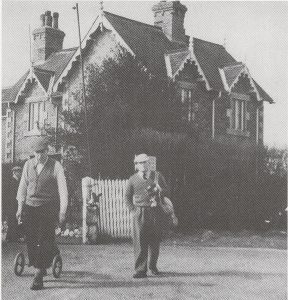
Going out: Howell Edwards (on the left) with Tommy Brocken following (Gilly Lambert is in the background).
A quiet game of cards after the round: From the left Jed Tagg, Gilly Lambert (Captain 1927) with Brian Wells and Jack Rimmington (Captain 1963)
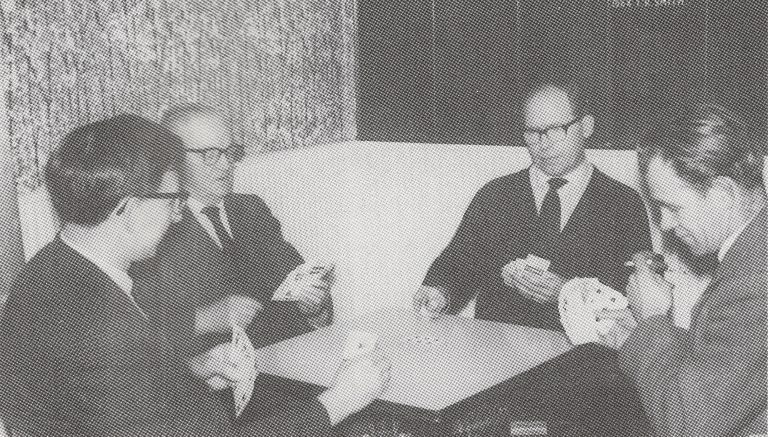
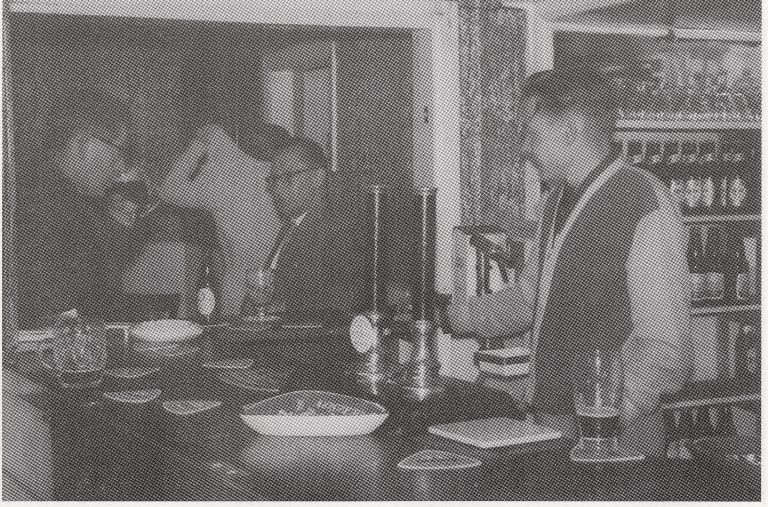
John Scott, in his role as steward, chatting with Howell Edwards on the left. John would sell you clubs and balls — and kept the greens as well!
Golf in winter! Gordon Adams watches Neil Connell with Harry Naylor and Fred Flower in attendance. When Harold Bright moved to Derby in 1967, Gordon took over as Competition Secretary for the next 22 years.
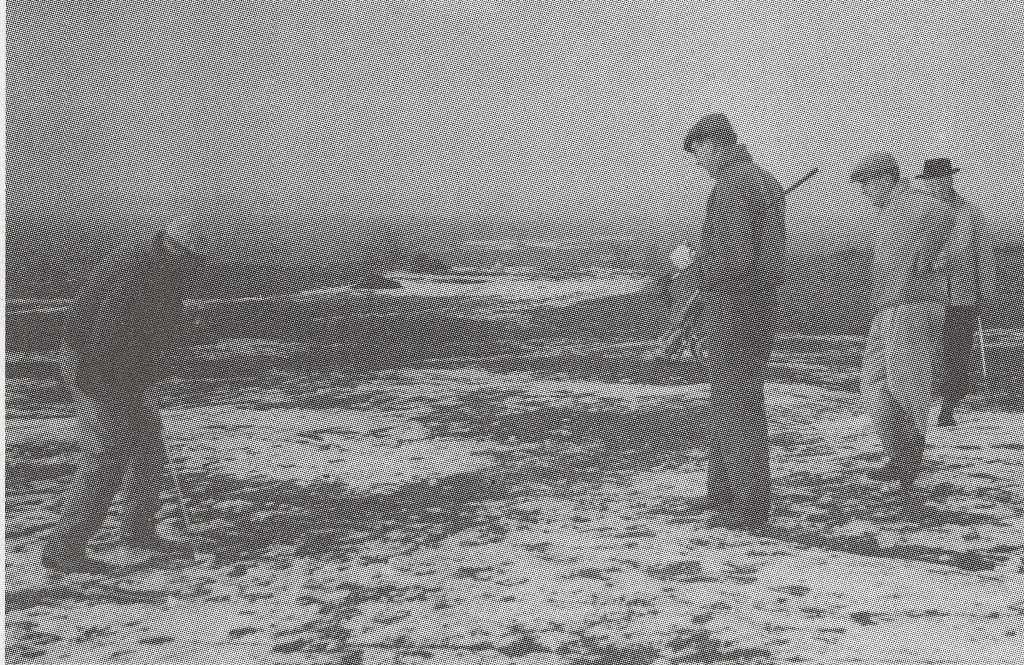
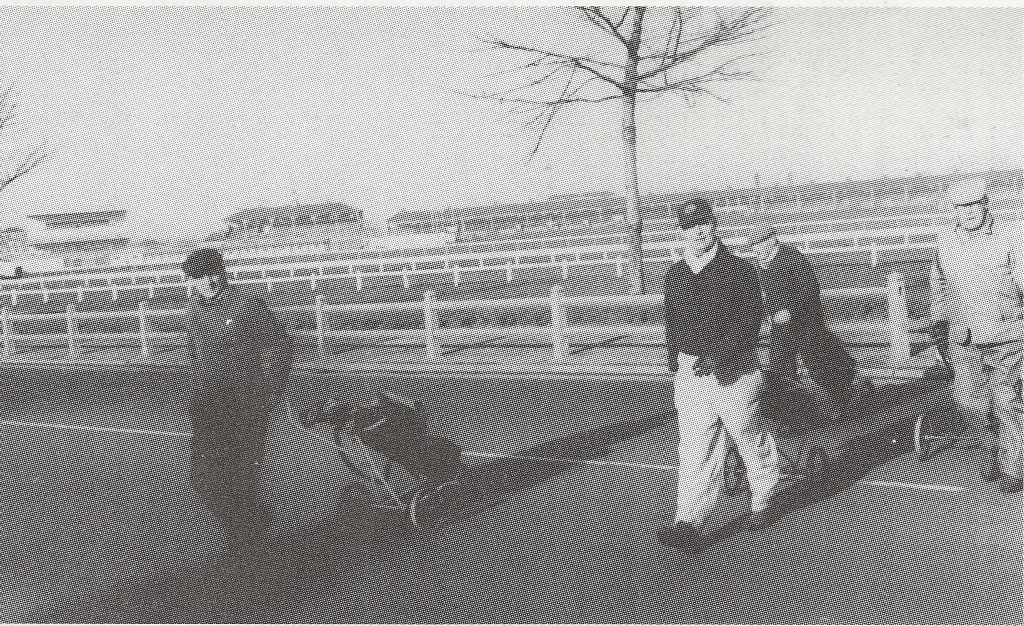
Returning: Terry Pownall, Alf Tagg, Fred Flower and Arthur Richardson.

1965: The ladies in their locker room at Neatherd’s House. From the left, at the back, Ruth Bridgewater, Queenie Wilson, Eileen Adams, Marcia Kirkham, Joan Robinson, Joan Bright, Renee Clark, Irene Chesterton. Seated from the left: Gladys Oldfield with Lily Meggitt (Lady Captain).
1969: The Lady Captain, Eileen Adams, with Les Wills and his wife on her left. With her is Denis Dean (Captain, Doncaster GC and his wife) together with Stan Allanson (Captain, Wheatley GC and his wife).

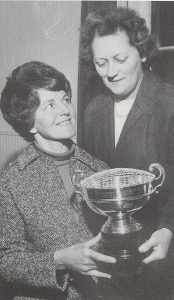
1966 — Lady Captain Gladys Oldfield presenting the Rosebowl to Belle Hopkinson. (By courtesy of the Yorkshire Post.)
1970: Kay Beech, Gladys Oldfield, Queenie Wilson, Julie Horncastle (Lady Captain), Marcia Kirkham and Lily Meggitt with the new Racecourse Grandstand in the background.


1970: Captain Geoff Mann presents Peter Tupling and his father, Len, with the prize for the Impel 70 Pro-Am at Town Moor. The winning score was 63.
1973: The Captain, Tom Hughes, chatting with steward Roy Grinhaff over the old bar at Neatherd’s House. In the background is the late Jimmy Hall (Captain, 1977).
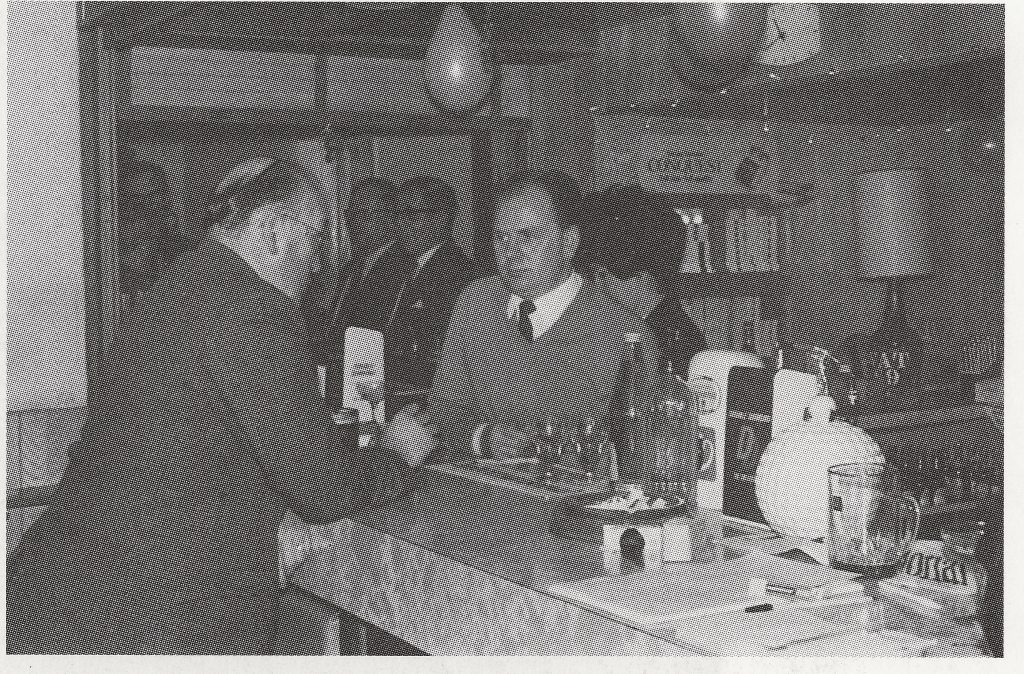
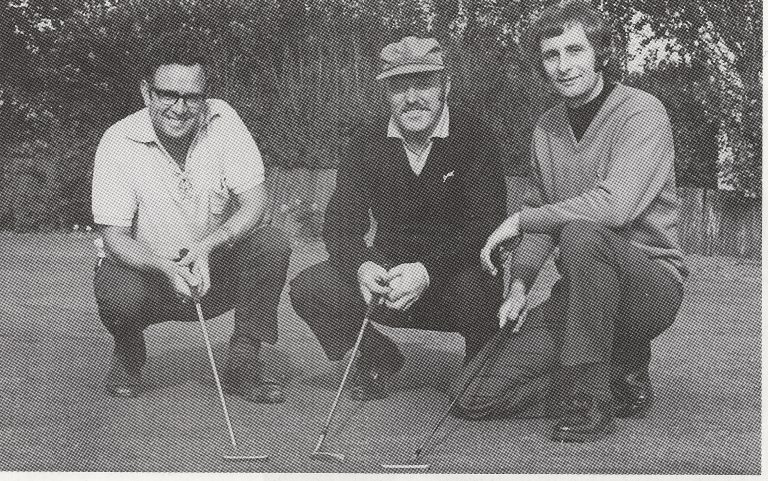
1972: Town Moor defeated Tapton Park 5/1 to clinch the Division 3 title in the Sheffield Union Golf League. Left to right, Bob Ducker, Ted Ayling and Trevor Smith. (By courtesy of Doncaster Newspapers Ltd.)
The winning Danum Cup team of 1974 with Club trophies. From the left, Doug Bint, Ian Hughes, Peter Law, Ray Bint, Duncan Hughes, Ted Ayling and Clive Dale.

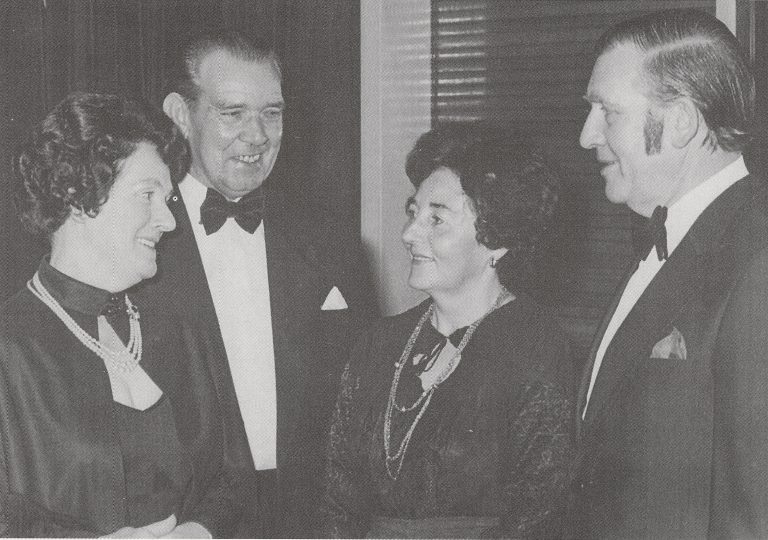
1976: The President, Don Richardson is pictured here with Captain, Tom Broxham (on the right). When Don died in 1983, Tom became President. On the left is Mrs Broxham; Irene Hunter (Lady Captain) is in the centre
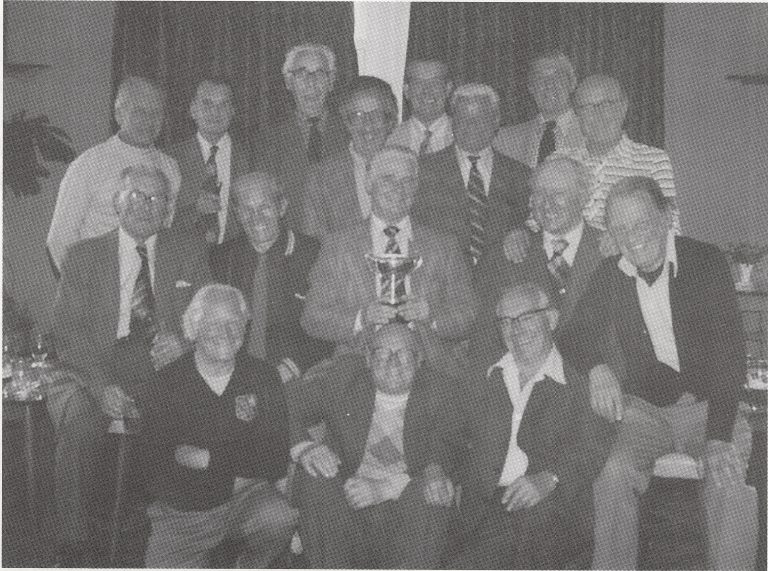
Alf Tagg, winner of the Veterans Trophy, surrounded by (back row, from the left): Jack South (who, when he was a youngster, caddied for the great James Braid), Wilf Morley, Jack Parslow, Bruno Giannini, Don Richardson, David Gould, Jim Richardson and Les Carpenter. Middle row: Arthur Richardson, Frank Mears, Alf Tagg, Jack Davidson, Les Oldfield. Front row: Dickie Foster, Herbert Walker and John Whitfield.
As the development of the airfield as a leisure complex became a reality, with the support of the Council, plans were drawn up to build a new Club House on the triangular piece of land near Rose Hill, between the race track and the A638. This plan was scotched when the Doncaster Civic Trust raised objections on the grounds that the whole area was common land.
The matter was taken before Mr Justice McCullough in the Queen’s Bench Division. On 11th October 1986, he ruled that the golf club did not have exclusive rights of possession and gave his verdict that what everyone had assumed to be the case was correct, namely that the public’s use of Doncaster Common was not only lawful but as of right.
The important consequence of this judgement was that the Club was now denied any opportunity to build a Club House in the immediate vicinity of the golf course. This left the Club high and dry and the rapid progress of plans to develop the Dome leisure complex made the problem acute.
The Council-owned Red House Farm site was further considered (as it had been once many years earlier), but the difficulty lay in securing access to the golf course, for the Race Committee would not countenance a permanent path which crossed the race track on the approach to the final straight. At one stage the feasibility of placing a moveable footbridge over the track was investigated, but the cost was of the order of £40,000 and apart from the inconvenience, this was rejected as an excessive strain on the Club’s finances.
THE END OF AN ERA
Passions ran high in 1988, when it was made clear that the Council intended to give the Club notice to quit Neatherd’s House, the presence of which it was claimed obscured the approach to the Dome. By now, a roundabout had been constructed on the A638 to serve the new development and the road ran almost within an arm’s length of one corner of the extension. Notice to quit was served for 1st May and the Club’s legal advisers urged the members, however unpalatable they regarded the situation, to bow to the inevitable.
Town Moor Golf Club was now enduring yet another bleak moment in its history. For Club President, Tom Broxham, Hon. Secretary, John Padley and the committee, who had fought so hard for the Club’s survival, it was a bitter blow — for Neatherd’s House had been a home for the Club for as long as any member (apart from Les Oldfield) could remember…
Providentially, help was at hand, for the Directors of Doncaster Rovers FC threw the Club a lifeline with an offer of tenancy of their Social Club. Hasty arrangements were made to transfer the Club across to this, the only possible haven, and on 3rd May 1988, demolition of the 135 year old Neatherd’s House commenced.
It was the end of an era. An era which left many members with fond memories of a Club House which had, despite its limitations, an atmosphere — an atmosphere redolent of prizegivings, of New Year parties, of friendly banter and leg-pulling and perhaps most of all, the intimacy of a drink and a game of cards in the tiny bar after a hard-fought fourball played against fellow members who were not only your rivals but who were also your friends. For many such members, Town Moor would never be quite the same again…
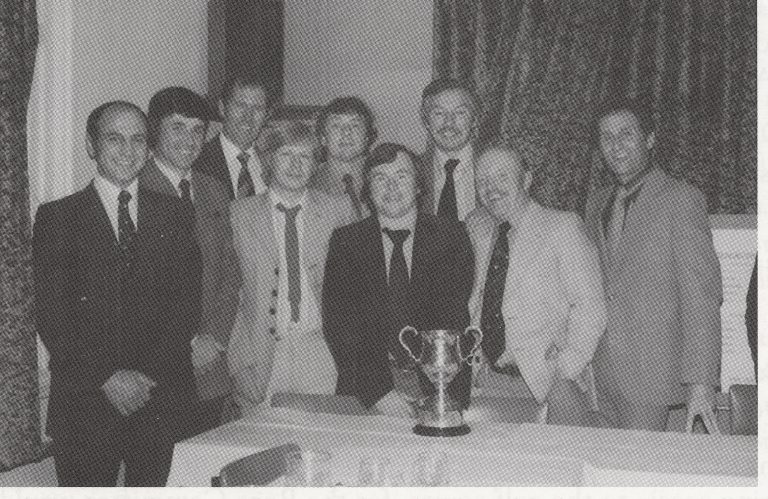
The winning 1980 Danum Cup Team, from the left: Keith Howarth, Geoff Scaife, Ron Mortlock (Captain), Clive Dale, John Kirk, John Bennett, John Barron (Hon. Secretary), Ted Ayling and Trevor Smith
Past Captains outside Neatherd’s House prior to demolition. At the back, left to right: Wilf Morley, Gerry Sampson, Ron Mortlock, Gordon Adams and Eddie Bryce. Front: Fred Dowson, Jack Rimmington, Ted Ayling, Albert Burkill, John Barron, Tom Broxham, Les Wills and Norman Pugh.
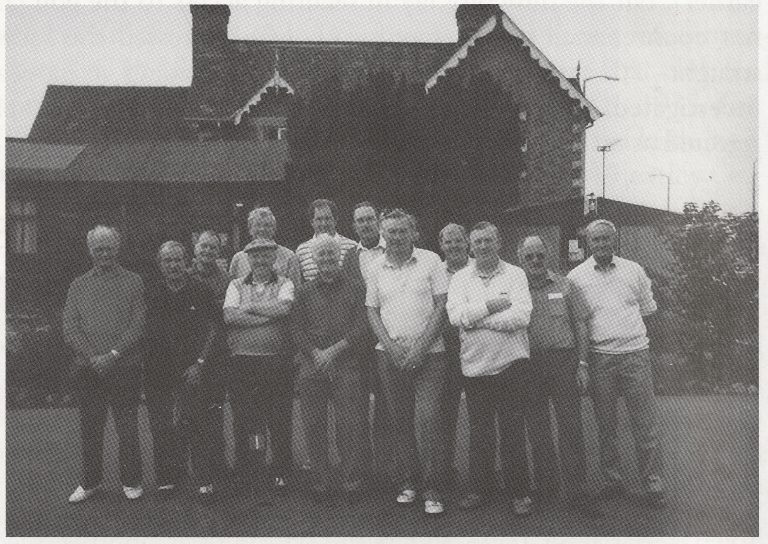
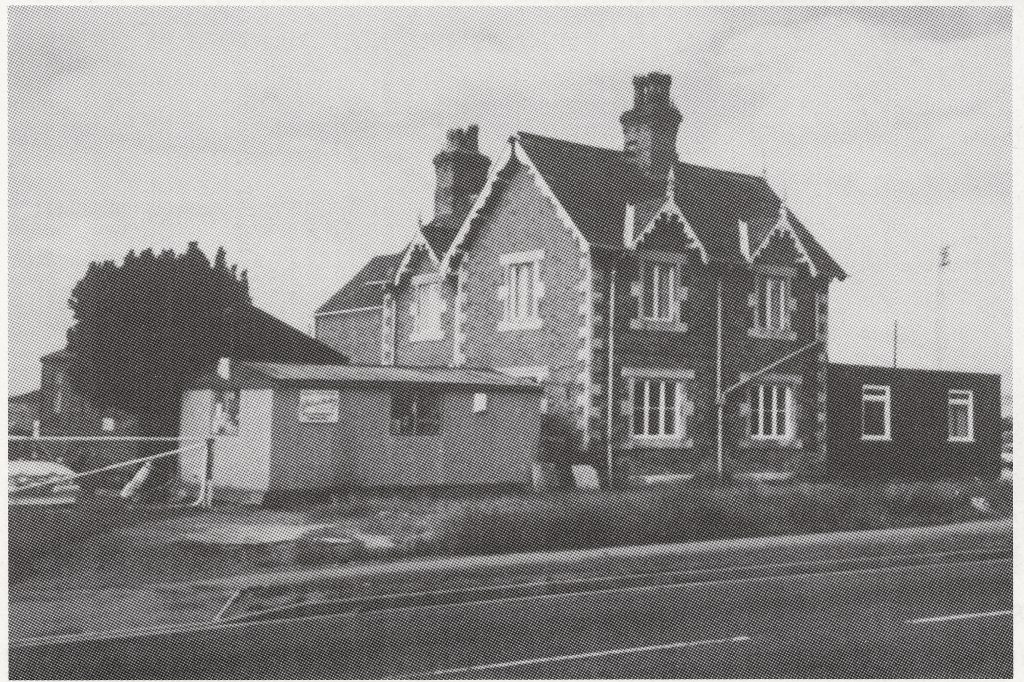
Neatherd’s House prior to demolition 3rd May, 1988. Designed by the architect, John Butterfield, it was built in 1853 to replace an old cottage burned down on the same site. It was ornately decorated as it occupied a prominent position on the approach to Doncaster. John Butterfield was a noted architect for he had also designed the now demolished Guildhall (1847) and the Market Hall (1849).
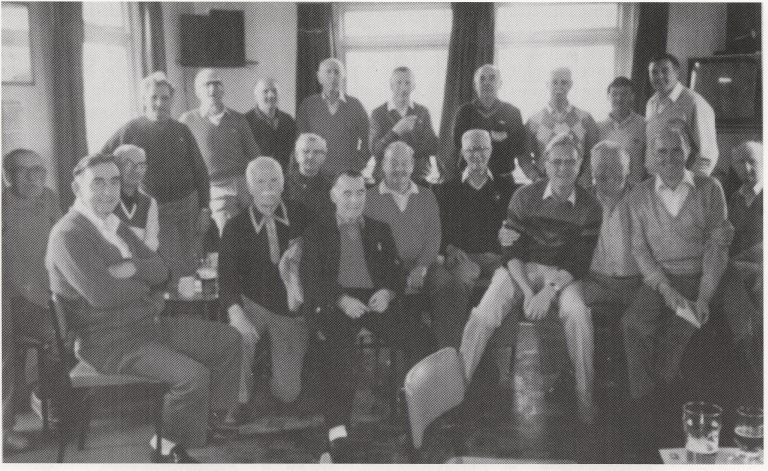
Taken in the extension at Neatherd’s House. At the back, standing: Basil Pilbrough, Ted Hill, Les Robinson, Ron Moore, Tom Broxham, Bob Clarke, Alf Tagg, Jim Meiklejohn, Ralph Fysh. Seated, middle: Ken Keen, Bob Crowe, Frank Siddons, Derek Jones, Doug Parkin. Front: Charlie Turner, Ken Brown, Ron Ward, Ron Grout, Albert Cowen, Walt Purser, P. Grogan.
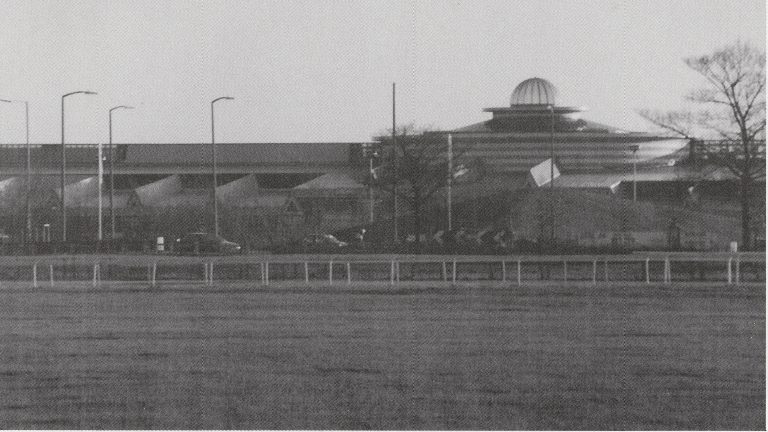
The Dome Leisure development seen from across the 1st fairway. The mound marks the site of Neatherd’s House.
Club members were now left with a much longer walk from their new base to the first tee but certainly no longer than it must have been in the 1920’s when they used the booths. Improvements were made, and in 1992, when the Rovers Directors decided to sell the Social Club, the Club purchased the premises for £220,000. Members were faced with a levy to help pay for this and have also had to face increases in subscriptions in order to facilitate the development of the property to the excellent standard we see today.
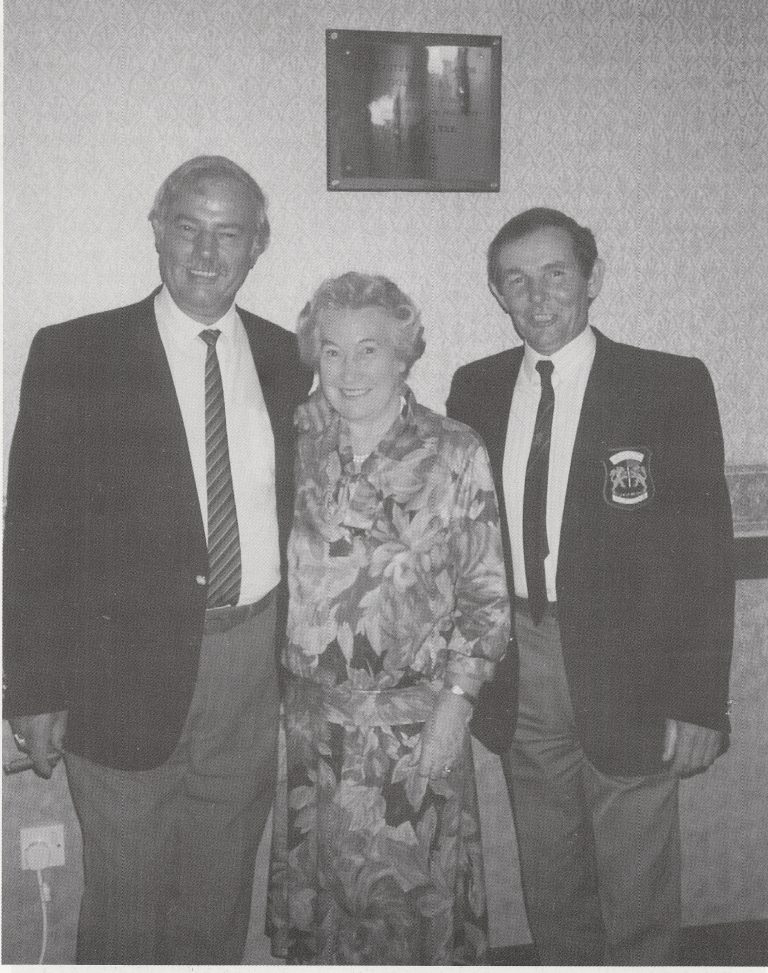
The Club House was officially opened on 31st July 1993. The President, David Walker (on the right), standing in front of the commemorative plaque in the entrance with the Captain, Denis Soar and the Lady Captain, Irene Chesterton.
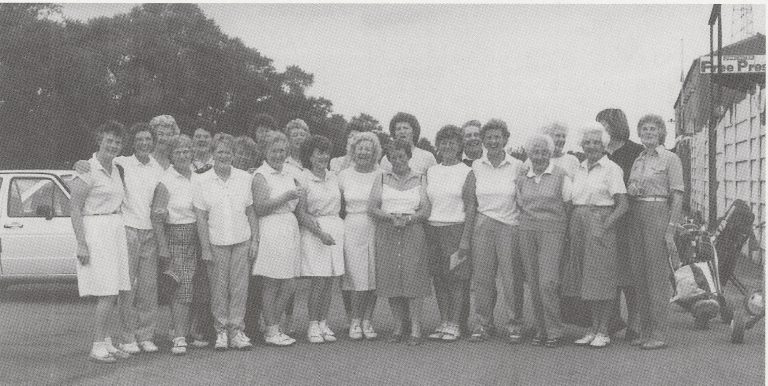
July 1989, Lady Captain’s Day. From the left: Margaret Burkill, Eileen Crowe, Eileen Adams, Norma Gladstone, Jean Sandland, Sadie Noonan, Meryl Bint, Gwen Edwards, Irene Chesterton, Betty Camm, Shirley Sykes, Ellie Bint (hidden), Dorothy Freeman, Betty Taylor (Lady Captain), Chris Raw, Belle Hopkinson, Jackie Isaacs, Julie Horncastle, Irene Hunter, Joan Robinson, Queenie Wilson, Joan Graham (side), Muriel Grainger.
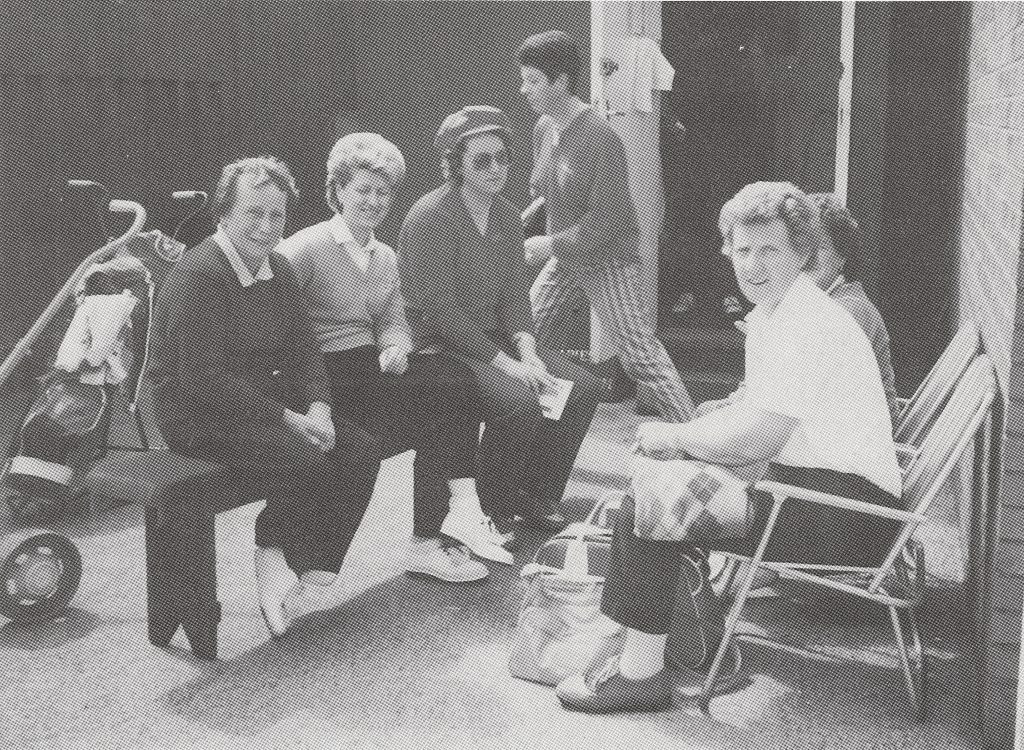
1988. After the move to Belle Vue, a group of ladies outside the first ‘locker room’ at the Rovers Social Club. The furniture had to be lifted out before they could go inside! On the left: Betty Taylor, Josie Parker, Chris Raw, Ellie Bint. On the right: Julie Horncastle and Shirley Sykes (hidden)
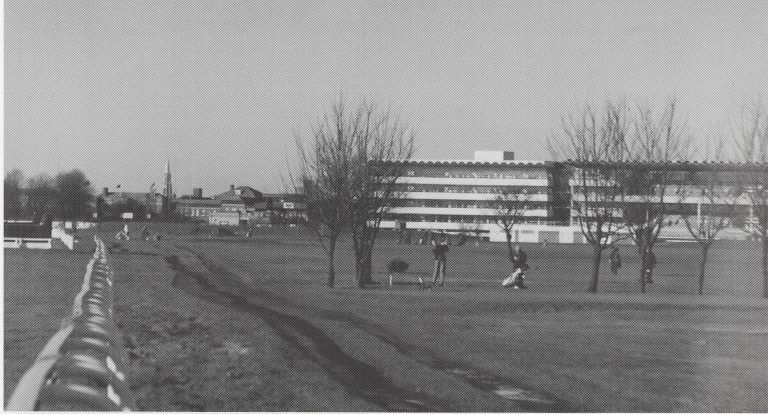
A view of the 2nd tee from higher up the hill. The spire of the now closed Christ Church is visible.
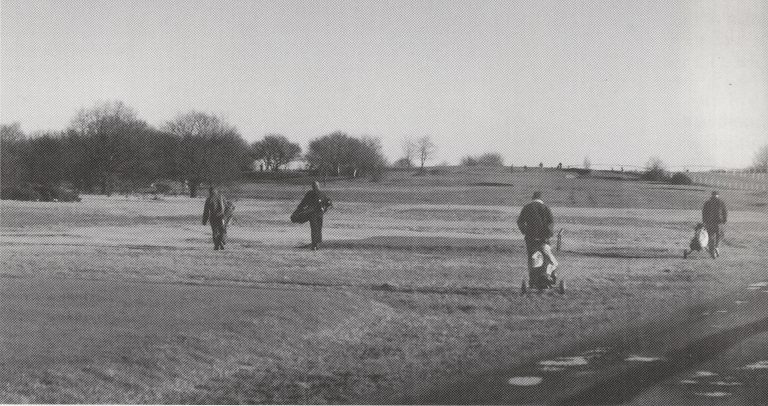
Players moving away from the 2nd tee. Beyond them lies the area occupied by the quarry.
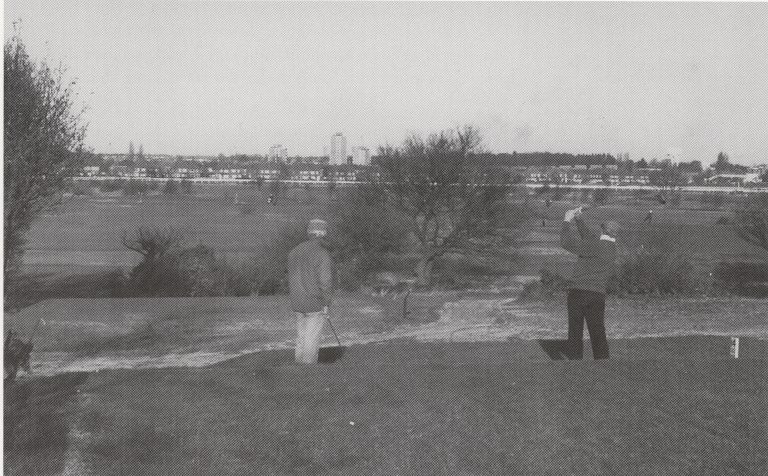
Driving off the 14th tee we can see the Intake Estate, in the background.

The present 17th hole was the first to be laid when the course was altered to 10 holes.
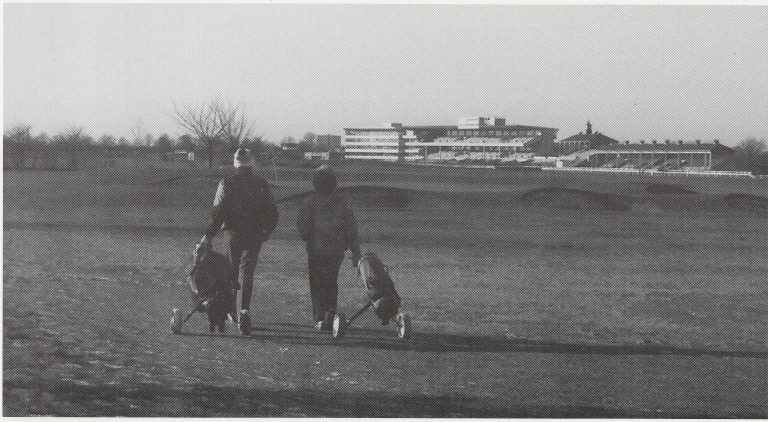
Play on the 13th green
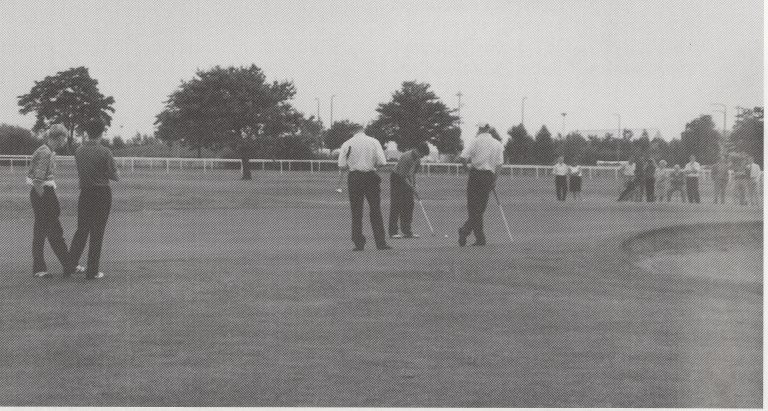
Putting on the 18th green – Junior Danum Cup, 1994
POSTSCRIPT
Over the years several youngsters who learned their golf on Town Moor have made their careers in the professional game: DAVID JAGGER joined Town Moor in the early sixties at the age of 12. David recalls how he had the temerity to turn up on Town Moor armed with a club and ball only to be confronted by Gordon Adams! In those days, youngsters did as they were told and David went over to Neatherd’s House, where John Scott made him a junior member on the spot for Et ! David stayed at Town Moor for two years before moving on to Wheatley GC and then to a highly successful career as a Tournament Professional. He is presently PGA Professional at Hull GC.
ANDREW HALL was one of the most successful of the crop of Town Moor Juniors of the 70’s. He is the son of Cynthia and the late Jim Hall, both former captains. On leaving school, he was appointed Assistant Professional at Rotherham GC. He stayed there for 21/2 years before moving to The Berkshire GC in 1976. During this time he spent 2 years on the Tour. In 1982, he was appointed Professional to Blackmoor GC (Hampshire) where he remained for the next 11 years. Andrew is now Director of Golf at Sand Martins Golf Club, Berkshire. During the past 6 years he has been one of Golf World Magazine’s Schools Instructors and for the last 3 years has been a teaching panellist, contributing regular instruction articles to the magazine.
Andrew was also Chairman of the Professional Golfers Association, Southern Region in 1992/3.
Don Richardson, President, with a very youthful Andrew Hall. (By courtesy of Doncaster Newspapers Ltd.)

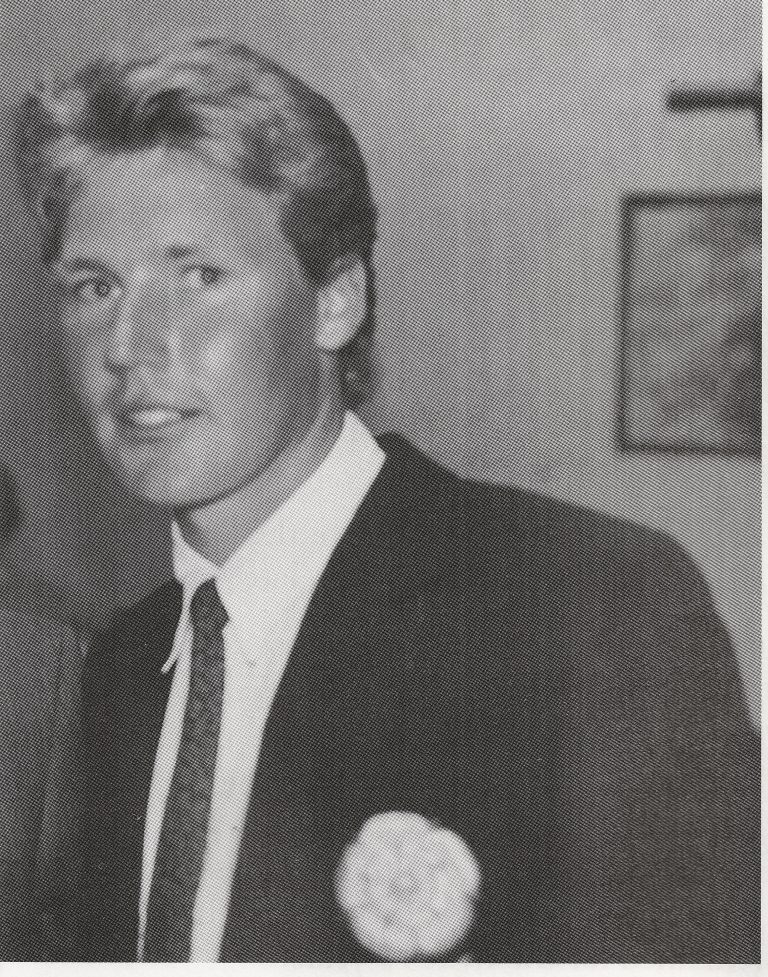
ANDREW MILLER joined Town Moor as a junior in 1980 and received every encouragement from his father and older brothers, Paul and Peter (who were both single figure golfers), to play the game. His talent became apparent when, in 1985, he won the Sheffield Union Junior Championship. He followed this with the Yorkshire Boys Championship in 1986 and went on to win the Sheffield Union Executive Trophy in consecutive years, 1987-88. In July 1987, playing in the Tigers Single Medal, Andrew (playing off 1 handicap) shot a gross 64 — a course record. Altogether he represented the Sheffield Union on 18 occasions and in 1987, he was selected to play for Yorkshire whom he represented 19 times.
In 1989, after a highly successful amateur career, Andrew became Assistant Professional to Graham Bailey at Scunthorpe GC and in 1992, he moved with Graham to his present situation at Doncaster GC. He finished the 1994 season lying second in the Northern PGA Assistants Order of Merit.
Andrew Miller wearing his county blazer.

The entrance to the present Club House
CONCLUSION
The great lesson of history is that in every field of human endeavour, nothing remains the same. Change, whether for good or bad, is inevitable. Since a golfer hit the first drive on the Race Common in 1895 with a gutty ball perched on a pile of sand using a hickory-shafted driver, the country has endured two world wars and immense social and economic changes have taken place — all of which have deeply affected the Doncaster area. No doubt that golfer would be astonished to see today’s golfer teeing up a balata ball on a plastic peg and swinging a carbon-shafted driver!
But the game of golf remains essentially the same… and always will.
Last year Doncaster celebrated the 800th Anniversary of the granting of its Charter by Richard I in 1194. The town became a county borough in 1927 and since 1974 has been a metropolitan borough. The history of golf on Town Moor spans the development of the previously privately-owned coal mines into a nationalised industry in 1947 which provided employment for thousands of people and has seen it go into decline and return into private ownership. The railway engineering industry too, has suffered grievously. Other industries have declined and it is clear that the industrial base of the area from which many Town Moor members earned their livings has gone; future members will be drawn from people who will only be aware of such things by reading accounts such as this.
There have been several occasions in the last hundred years when it seemed that golf on Town Moor would disappear forever. But golfers are a hardy breed, they are not easily deterred and each time, through the efforts of dedicated people, the Club has risen like Phoenix from the ashes.
And so it never ends. The Club’s problems are ongoing; the course is presently being reconstructed to accommodate a 40 yard incursion of the racing facilities within the existing perimeter. No doubt this will become the first consideration of the golfing historian who writes the history of the next hundred years — for we are left with the hope that come what may, golf will always be played on Doncaster Town Moor.
APENDIX
PRESDIDENT
1914 | W.W Warde-Aldam |
1915 | Sir Charles Nicholson MP |
1921-23 | The Mayor of Doncaster |
1923-44* | T.W. Plant |
1944-53* | W.D. Morton |
1953-56 | G.E. Blackbourn |
1957-63 | A. Richardson |
1965-68 | W.L Oldfield |
1968-76 | C.W. Morley |
1976-83 | D. Richardson |
1983-91 | T. Broxham |
1991- | D.J. Walker |
HON. SECRETARY
1911 | Dr Langley | 1950-52* | E. Blackbourn |
1914 | C. Scorah | 1952-55* | A.R. Rose |
1915 | F. Walker and S.G. French | 1955-64 | W.L. Oldfield |
1921 | L. Vaughan | 1965 | G. Mann |
1927-34 | G.C. Knott | 1966 | J.C. Padley |
1935 | A. Ansell | 1967-73 | E.A. Merryweather |
1936 | E. White | 1973-86 | J. Barron |
1938-42* | T. Rhoden | 1986-91 | J. Padley |
1942-50* | H. Firth | 1991 | G. Sampson |
HON. TREASURER
1914 | C. Scorah | 1961-64 | M. Cartwright |
1921 | Mr Baguley | 1964-89 | W.L Oldfield |
1932-42* | Miss E.M. Lister | 1989 | A. Gough |
1942-50* | Miss Grimshaw | 1990-93 | J.H. Senior |
1950-61 | J.A. Dentith | 1993- | L. Sanderson |
1959-60 | W.L. Oldfield |
|
|
*These dates are approximate as the Management Committee Minutes exit only as far back as 1960
CAPTAIN
1923 | L. Shore | 1959 | N. Abbott |
1924 | F. Turner | 1960 | F. C. Flower |
1925 | T. Summers | 1961 | J. Smith |
1926 | W. Webb | 1962 | G. A. Adams |
1927 | E. G. Lambert | 1963 | J. Rimmington |
1928 | T. Rennie | 1964 | J. Clough |
1929 | J. Kitchen | 1965 | E. W. Ayling |
1930 | H. A. Shelbourn | 1966 | C. W. Morley |
1931 | S. Taylor | 1967 | H. Duffin |
1932 | H. B. Wilson | 1968 | C. C. Knight |
1933 | H. K. Bailey | 1969 | A. L. Wills |
1934 | A. Richardson | 1970 | G. Mann |
1935 | A. Richardson | 1971 | Richardson |
1936 | A. Peart | 1972 | J. Davidson |
1937 | A. Vasey | 1973 | T. Hughes |
1938 | W. L. Oldfield | 1974 | A. Garner |
1939 | J. Howden | 1975 | No Appointment |
1940 | W. Hopton | 1976 | T. Broxham |
1941 | A. Richardson | 1977 | J. Hall |
1942 | A. Richardson | 1978 | F.N. Dowson |
1943 | W. D. Morton | 1979 | W. H. McHugh |
1944 | H. Harvey | 1980 | R. Mortlock |
1945 | S. Timms | 1981 | N. Pugh |
1946 | H. Harvey | 1982 | Sampson |
1947 | G. Barnes | 1983 | T. Broxham |
1948 | A. Vasey | 1984 | A. Burkill |
1949 | W. L. Oldfield | 1985 | J. E. Bryce |
1950 | F C. Bingham | 1986 | J. Barron |
1951 | F. C. Flower | 1987 | J. Barron |
1952 | H. Burgin | 1988 | D. C. Bint |
1953 | B. Miller | 1989 | L. Sanderson |
1954 | E. Smedley | 1990 | D. J. Walker |
1955 | J. Dentith | 1991 | M.-Deighton |
1956 | J. Howden | 1992 | A. Gough |
1957 | P. Robinson | 1993 | D. Soar |
1958 | P Robinson | 1994 | G. A. Hanson |
|
| 1995 | A. W. Cowen |
LADY CAPTAINS
1935 | Mrs E Timms | 1955 | Mrs M. Kirkham | 1975 | Mrs M. O’Shea |
1936 | Mrs A. Townend | 1956 | Mrs M. Kirkham | 1976 | Mrs J. Keen |
1937 | Mrs K. White | 1957 | Mrs M. Kirkham | 1977 | Mrs I. Hunter |
1938 | Miss E. Lupton | 1958 | Mrs E. Phillips | 1978 | Mrs M. Burkill |
1939 | Mrs E. Acaster | 1959 | Mrs I. Hopkinson | 1979 | Mrs B. Metcalfe |
1940 | Mrs E. Thirsk | 1960 | Mrs M. Milton | 1980 | Mrs C. Hall |
1941 | Mrs E. Heyes | 1961 | Mrs L. Morley | 1981 | Mrs P. Walker |
1942 | Mrs Lawson | 1962 | Mrs J. Holmes | 1982 | Mrs D. Freeman |
1943 | Mrs F. Timms | 1963 | Mrs Q. Wilson | 1983 | Mrs M. Bailey |
1944 | Mrs K. White | 1964 | Mrs L. Meggitt | 1984 | Mrs S. Bint |
1945 | Mrs E. Lambert | 1965 | Mrs L. Meggitt | 1985 | Miss C. Raw |
1946 | Mrs A. Barlow | 1966 | Mrs G. Oldfield | 1986 | Mrs J. Roper |
1947 | Mrs N. Townend | 1967 | Mrs I. E. Chesterton | 1987 | Miss V. Biggins |
1948 | Mrs E. Thompson | 1968 | Mrs J. Robinson | 1988 | Mrs J. Sandland |
1949 | Miss A. Ebblewhite | 1969 | Mrs E. Adams | 1989 | Mrs E. Taylor |
1950 | Mrs E. Lambert | 1970 | Mrs J. H. Horncastle | 1990 | Mrs J. Isaacs |
1951 | Mrs M. Kirkham | 1971 | Mrs N. Parslow | 1991 | Mrs S. Sykes |
1952 | Mrs D. Birkinshaw | 1972 | Mrs L. Morley | 1992 | Mrs D. Watts |
1953 | Mrs G. Burgin | 1973 | Mrs J. Robinson | 1993 | Mrs I. E.Chesterton |
1954 | Mrs S. Barkhouse | 1974 | Mrs J. M. Garrity | 1994 | Mrs N. E. Gladstone |
|
|
|
| 1995 | Mrs J. E. Graham |
NB: This list is incomplete for there is evidence that there were Lady Captains before the formation of the Ladies Committee in 1935, ie. 1933 Miss N. Howden (elected Captain) and Miss C. Cudworth (Vice-Captain) are mentioned in a press report of the AGM (Doncaster Chronicle, 16th March). So until 1935, it is reasonable to assume that the Ladies Section was run informally by the Captain assisted by her Vice-Captain.
LADIES SECRETARIES
1937-38 | Mrs Thirsk | 1962-67 | Mrs I. E. Chesterton |
1938-61 | Mrs L. Otley | 1967-81 | Mrs G. Oldfield |
1961-62 | Mrs E. Angus | 1981- | Mrs I. Hunter |
NOTE: Since 1988, the following have represented the Ladies Section on the Management Committee: Mrs J. Sandland, Mrs I. Hunter and Mrs J. E. Graham.
PROFESIONALS
1936-39 | Joe Garrod |
| Fred Bamford |
| W.P. Sedgwick |
| Willis Evans |
1958-67 | John Scott |
1967-72 | Ian Gosney |
1972-74 | Roger Jaynes |
1974-86 | Martin Ross* |
1986-89 | Graham Bailey |
1990- | Stephen C. Poole |
*Martin was only 19 when he joined the Club – the youngest PGA Professional in the country.
PRESENT COURSE RECORD HOLDERS
Profesional | Joe Garrod (68) |
Amateur | Fred Bamford (66) |
Ladies | Rebecca Hudson (Wheatley GC)(70) |
MAJOR TROPHIES
1923 | T. W. Plant Cup | 1982 | Scratch Trophy |
1936 | Wilson Cup | 1985 | Geoff Scaife Memorial Trophy |
1950 | Blackbourn Trophy | 1993 | Queen Mothers Cup |
1951 | Bamford Cup | 1994 | Maurice Birkett Driver |
1964 | Richie Cup |
| Captains Trophy |
1972 | Greens Cup |
| Presidents Cup |
1976 | Gilly Lambert Putter |
| The Graham Plate – Summer Foursomes Matchplay |
MAJOR TROPHIES – LADIES
1929 | Ladies Trophy |
1953 | Coronation Cup |
1964 | Ladies Rosebowl |
1968 | Skol Larger Cup |
1970 | Ruth Bridgewater Cup* |
1975 | Marcia Kirkham Cup |
1992 | Joan Keen Memorial Trophy |
1994 | Sue Bint Memorial Trophy |
*In 1993 several of the ladies visited Ruth on her 100th Birthday. Sadly she died the following year.
MIXED TROPHIES
1933 | Mixed Foursomes Cup |
1981 | Hunter Family Mixed Foursomes Cup (presented by Mrs Irene Hunter) |
1989 | Mixed Foursomes Matchplay Cup (presented by L. Sanderson) |
RABBITS TROPHIES
1967 | Greyhound Trophy (presented by C. D. and R. Bint) |
1993 | Diamond Trophy ( the ‘Rabbits Cup’) |
1969 | Roy Clark Memorial Trophy |
JUNIOR TROPHIES
1969 | C.A.L. Willis Junior Cup |
INTER-CLUB COMPETITIONS
DANUM HOTEL CHALLENGE CUP (known as the Danum Cup): Presented by Ind Coope Ltd in 1966. This is Doncaster’s premier golf event, played in turn over Town Moor, Wheatley and Doncaster courses. It is played for by teams of 8 players of which 4 must be 9 handicap or above. The lowest aggregate of the gross scores of all 8 players decides the winner. Town Moor have won the cup on 6 occasions — 1968, 1972, 1976, 1980, 1986 (tied with Wheatley GC) and 1989.
LADIES INTER-CLUB
DARLEY TROPHY: Inaugurated in 1980. Played on similar lines to the Danum Cup, the gross scores of 4 Silver and 4 Bronze Division players are aggregated to determine the winners. The Town Moor Ladies have won this competition once — in the year of its inauguration.
RABBITS INTER-CLUB
TRIDON SHIELD: Inaugurated in 1972. The section won this in 1979, 1986, 1991 and is the current holder (1994). QUADRADON: Inaugurated in 1977. The section won this in 1986 and is the current holder (1994).
JUNIOR INTER-CLUB
In 1977 the three local clubs inaugurated the Doncaster Golf Clubs’ Junior Trophy — known as the `Junior Danum Cup’. It is organised on similar lines to the senior event, but only 6 scores count out of 8. Wheatley GC have always dominated this event and Town Moor Juniors only success was when they tied with Wheatley in 1988.
ACKNOWLEDGEMENTS
The task of compiling a history such as this is a complex one. Club records in the form of Minute Books were only available from 1960 (the Ladies Section as far back as 1935). Minute books per se can only give part of the story; other information can be gleaned from a study of the local newspapers: this is particularly useful at times of crisis or sporting achievement.
I have laid great store by the verbal account of people who have been actively involved with the running of the club. Such stalwarts are often a fertile source of photographs and press cuttings which, but for a publication like this, would probably never again see the light of day. I was fortunate in having access to a corps of such people to draw on and whose contributions I acknowledge here.
My thanks go to the following:
Past President, Captain, Hon. Secretary and Hon. Treasurer, Les Oldfield, who freely gave his time and without whose assistance much of the early history of Town Moor would have been lost.
Former member Ian Smith (and his father, Keith), who allowed me access to much valuable information and many photographs and memorabilia relating to their family’s long connection with the Club.
Former President, Wilf Morley and past captain, Les Wills, who provided information regarding the development of the present course.
Maurice Birkett, who knew everyone who played golf in the Doncaster area in the last half century.
Irene Hunter, who provided information regarding the Ladies Section.
Dot Garrod (of Doncaster GC) who provided information about her late husband, Joe.
John Scott, who took the trouble to come over from Wetherby to point out the work he did on the course.
Mrs Doreen Richardson, who allowed me access to photographs and cuttings kept by the late Don Richardson. At one stage the Club had three generations of Richardsons actively playing golf at Town Moor, Arthur, Don and David.
Albert Burkill and his wife, Margaret, who put me in touch with former member, Harold Bright. Harold very kindly contributed the photograph of members at the opening of the bar in 1950.
John Padley, former Hon. Secretary, whose comments and advice on events during his term of office were invaluable.
Gerry Sampson, the Hon. Secretary, for so patiently fielding so many of my enquiries.
Club President, David Walker, former President, Wilf Morley, Les Wills, John Barron, Ted Ayling, Jack South, Trevor Smith, Peter Hipwell, Ray Bint, the late Jack Rimmington, Alf Tagg, Gordon Adams, Albert Cowan, Clive Dale, Belle Hopkinson, Queenie Wilson and Eileen Adams, all of whom helped in various ways.
Professionals and former members, David Jagger, Andrew Hall and Andrew Miller for providing information about their association with Town Moor.
The Editors of the Yorkshire Post and Doncaster Newspapers for permission to reproduce photographs and other relevant material from their archives.
Carol Hill and the staff of the Local History Section at Doncaster Public Library for their unfailing courtesy and willing help.
Tony Jackson, for permission to use his superb line drawing of Neatherd’s House on the front cover. The original is hung in the Club House.
Lastly, my wife, Julie, one of the Town Moor Ladies, without whose help and encouragement this project might never have seen the light of day.
